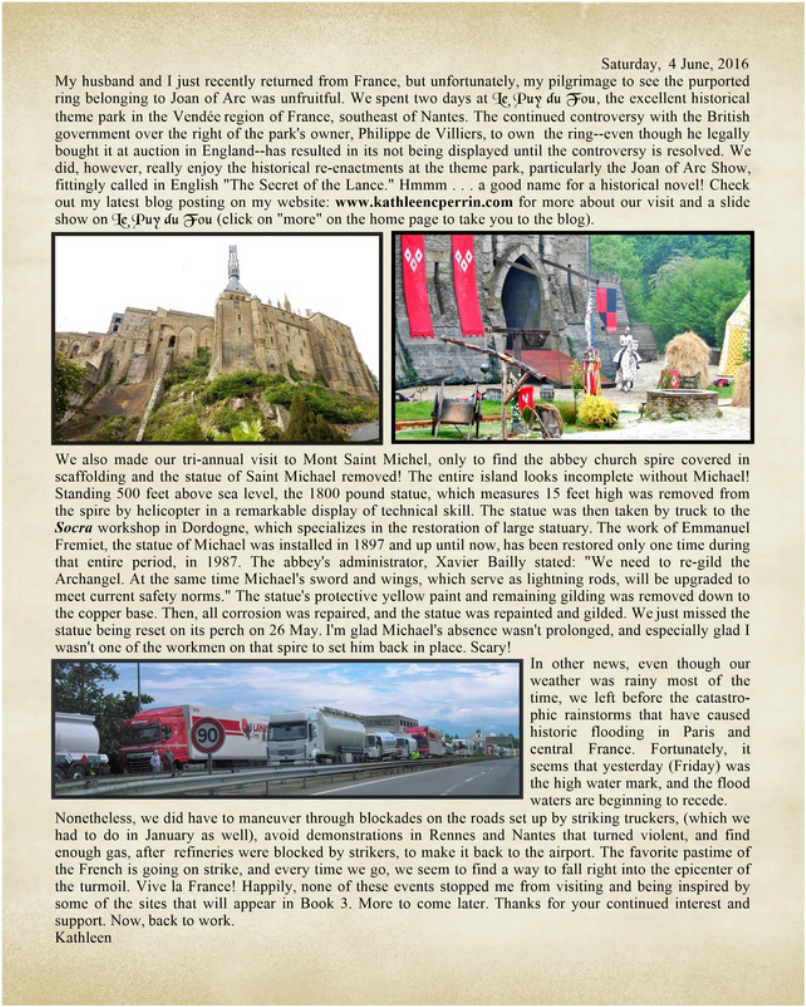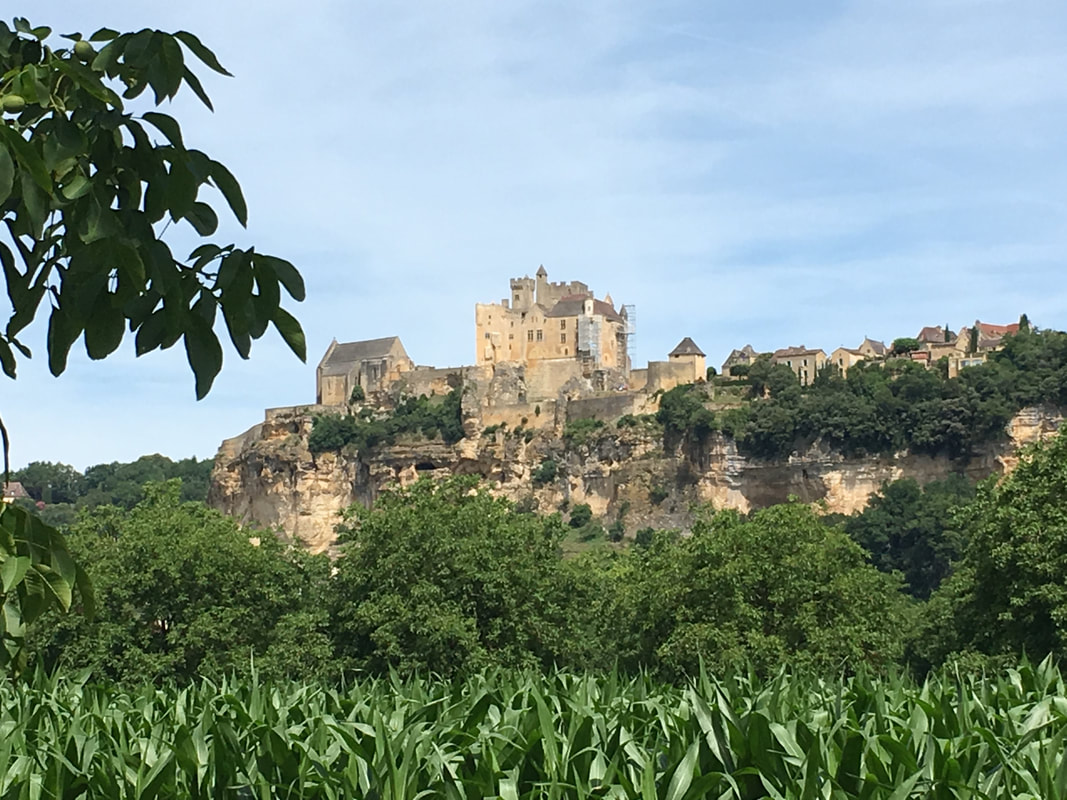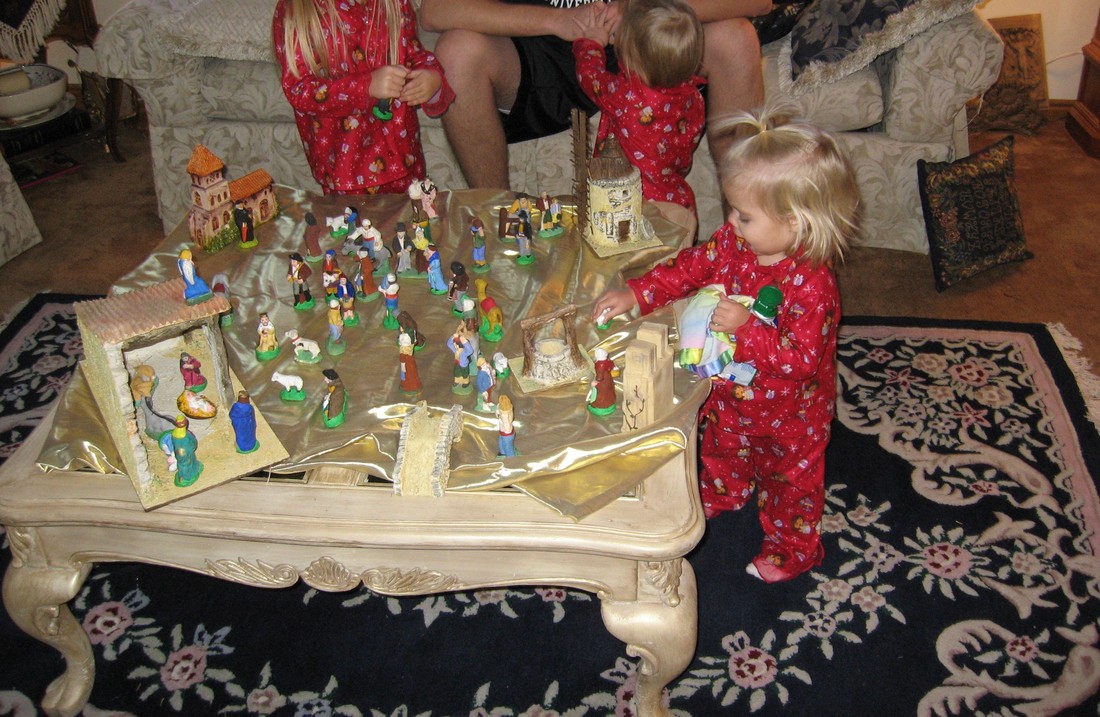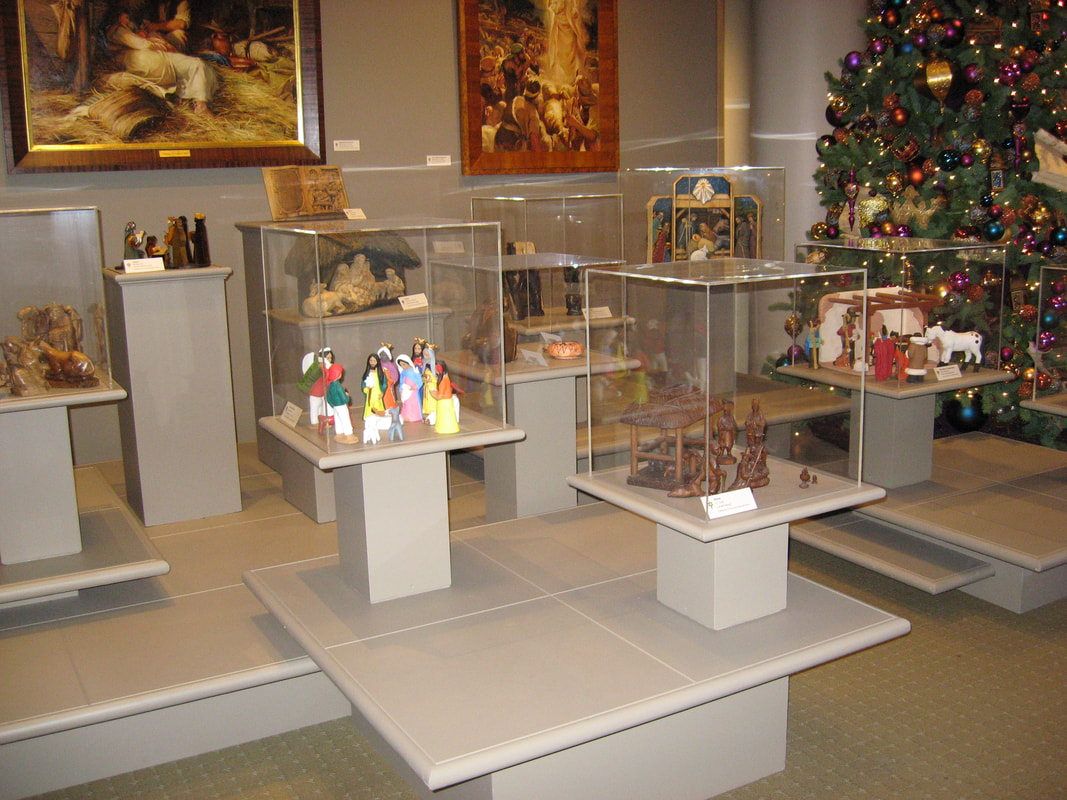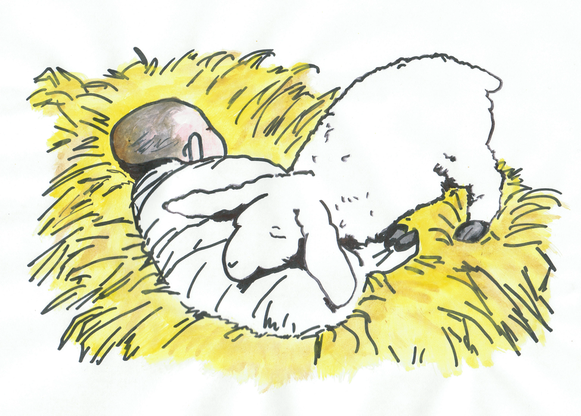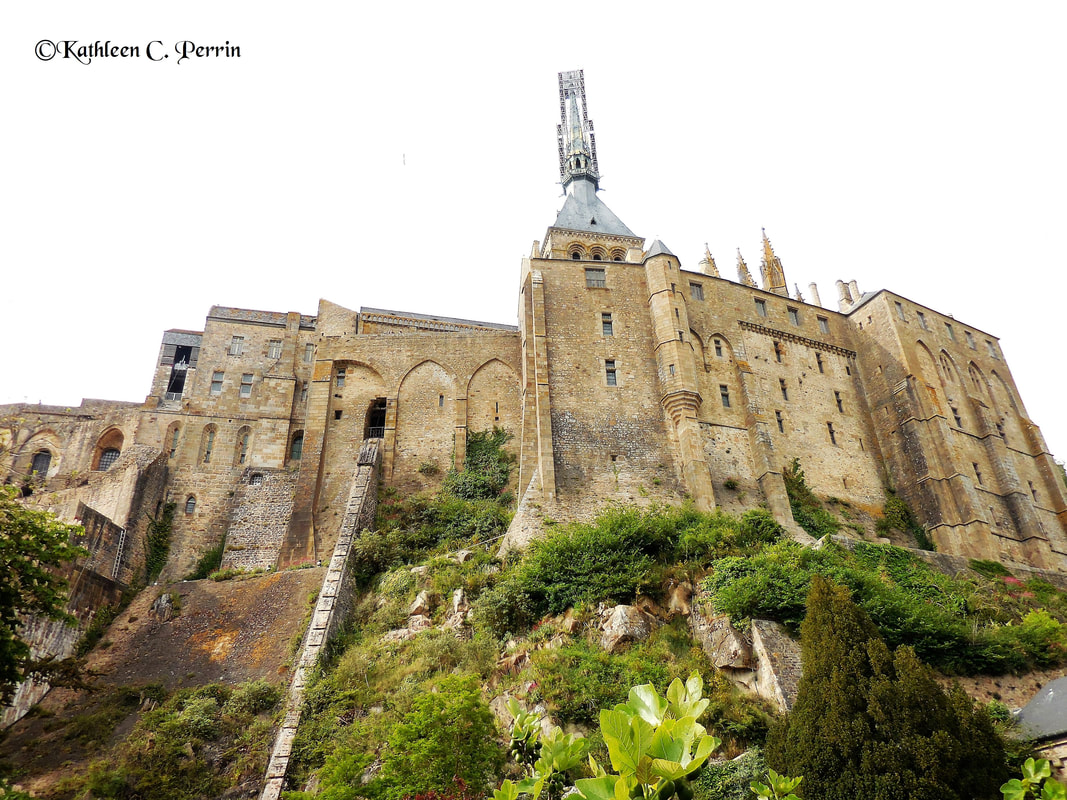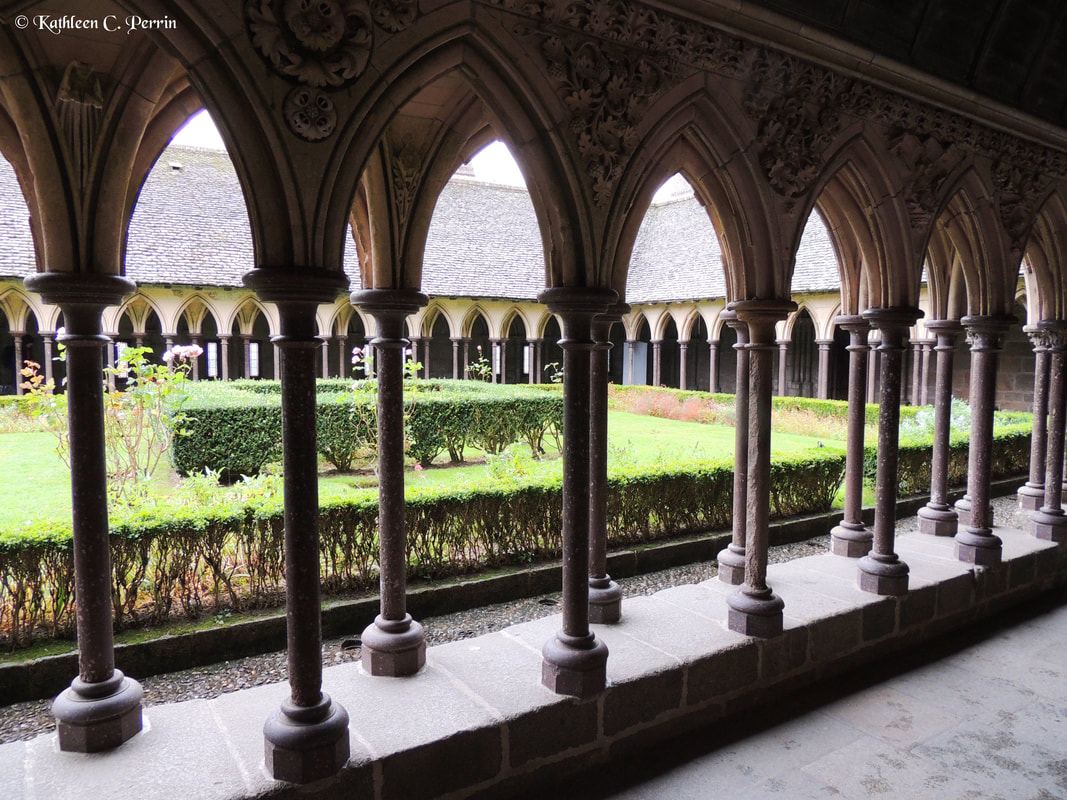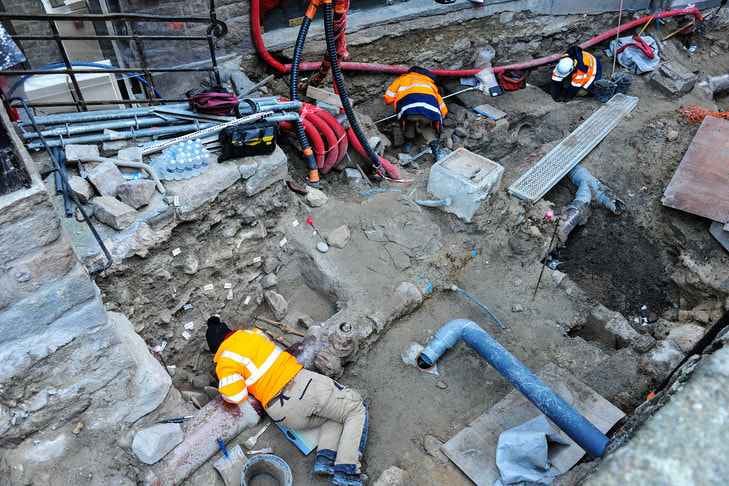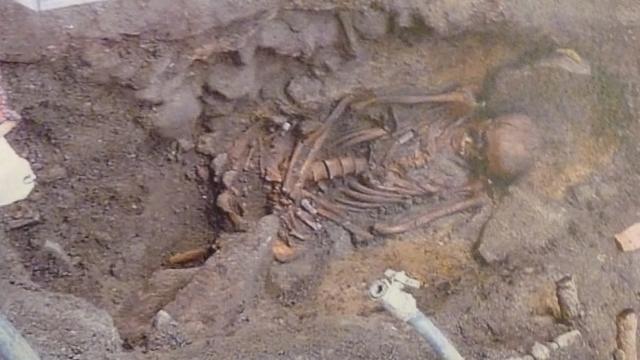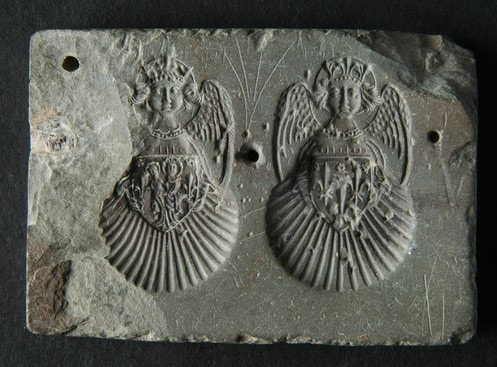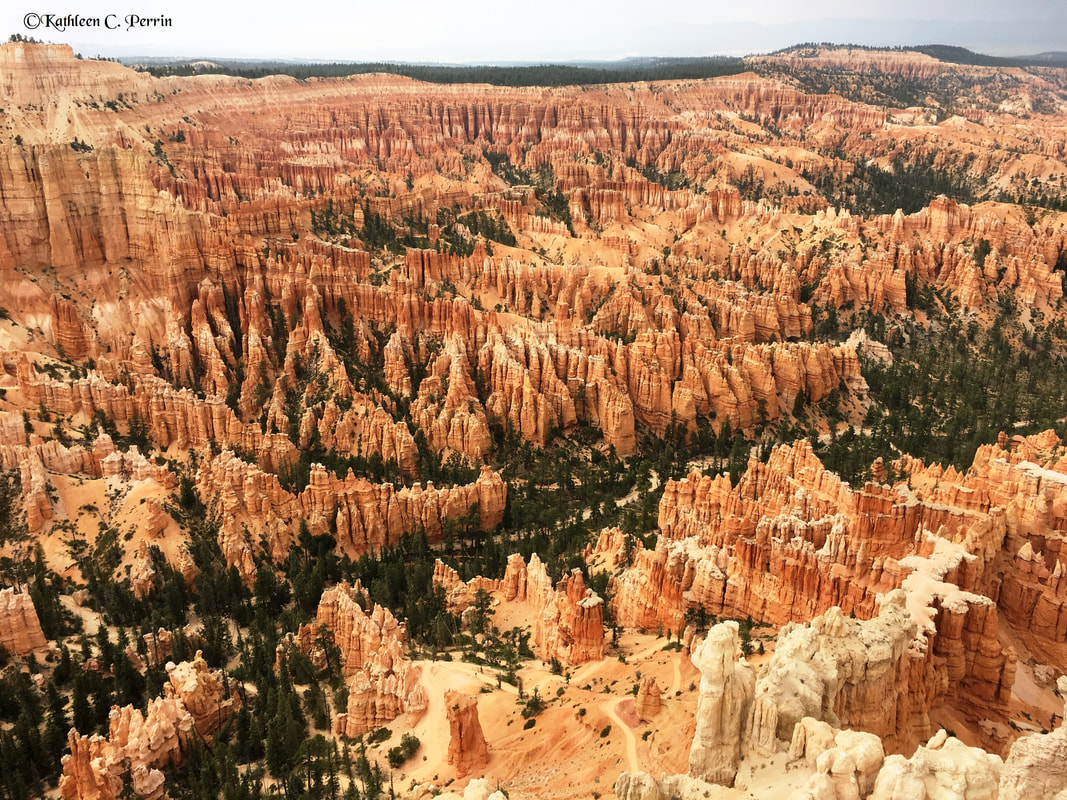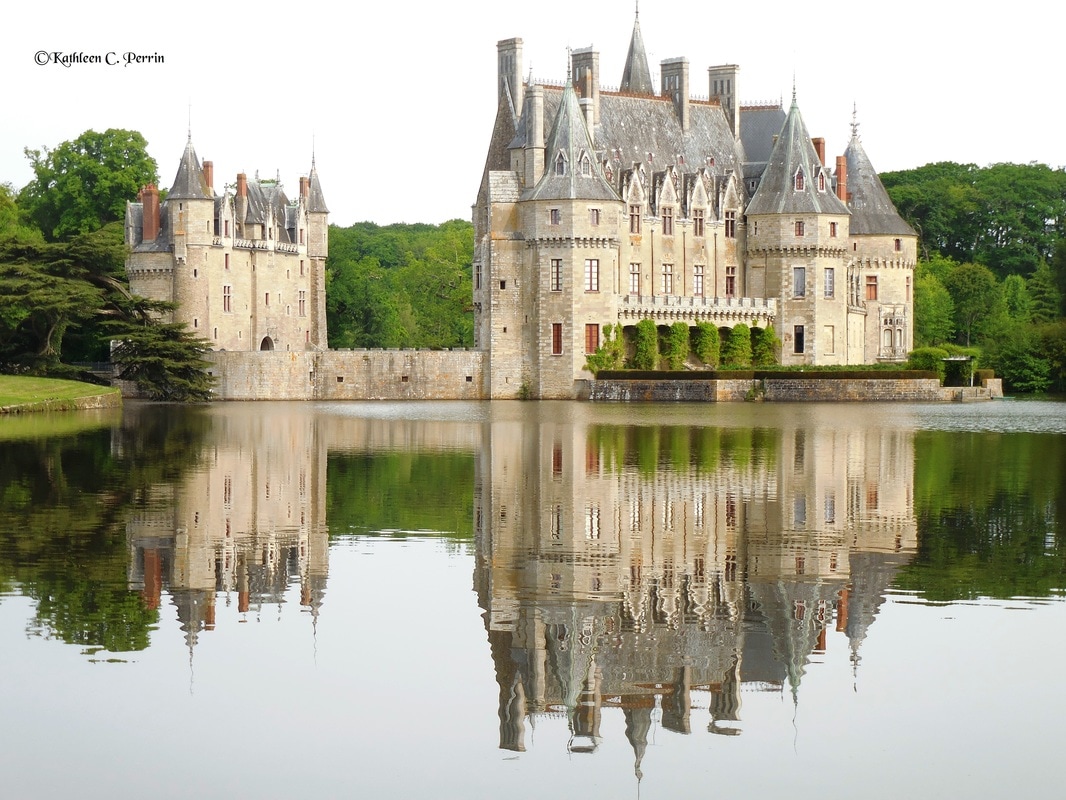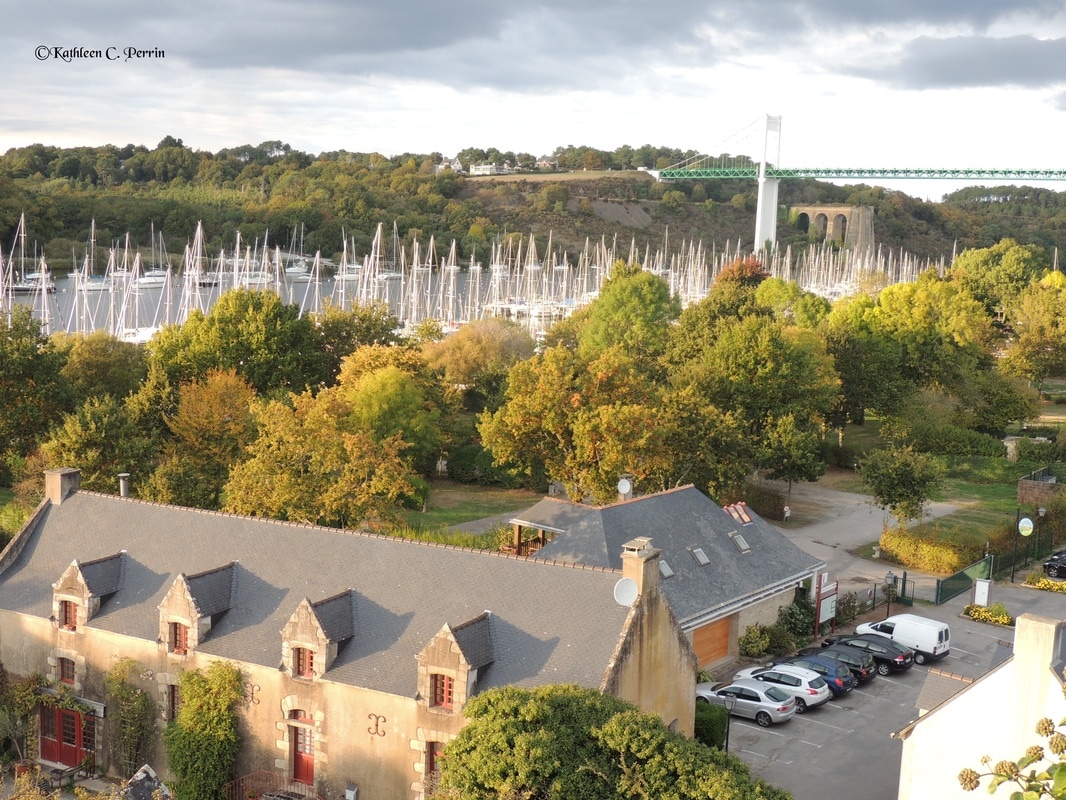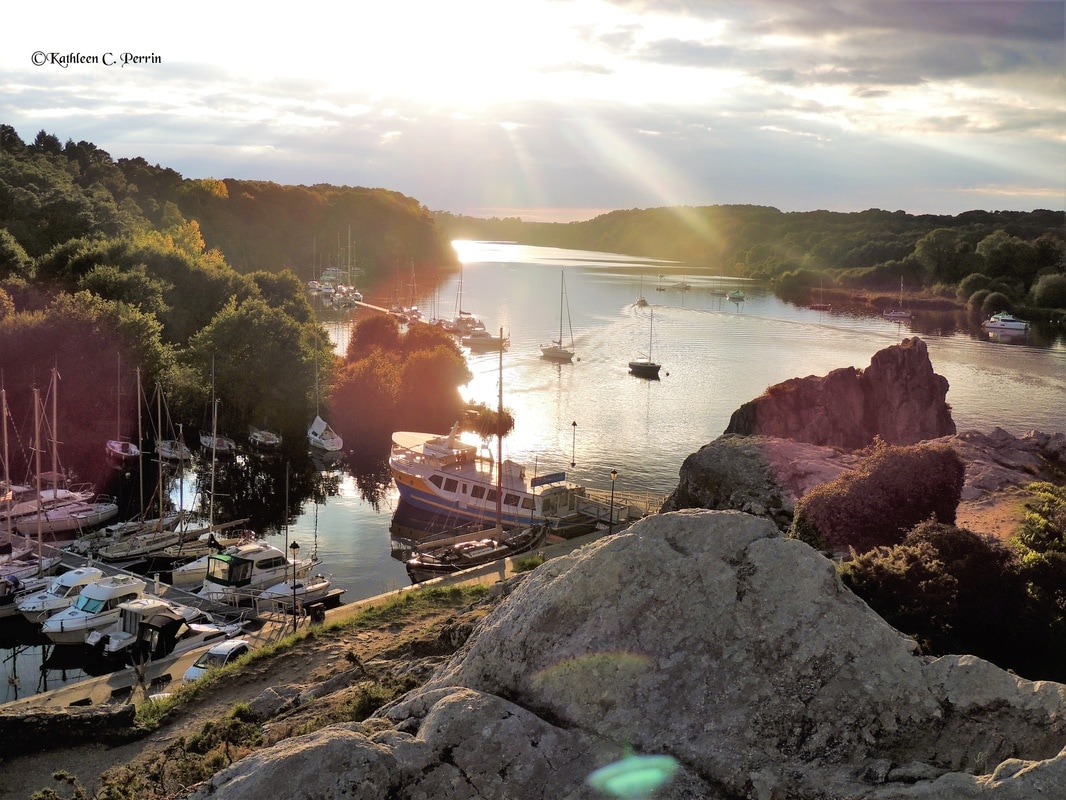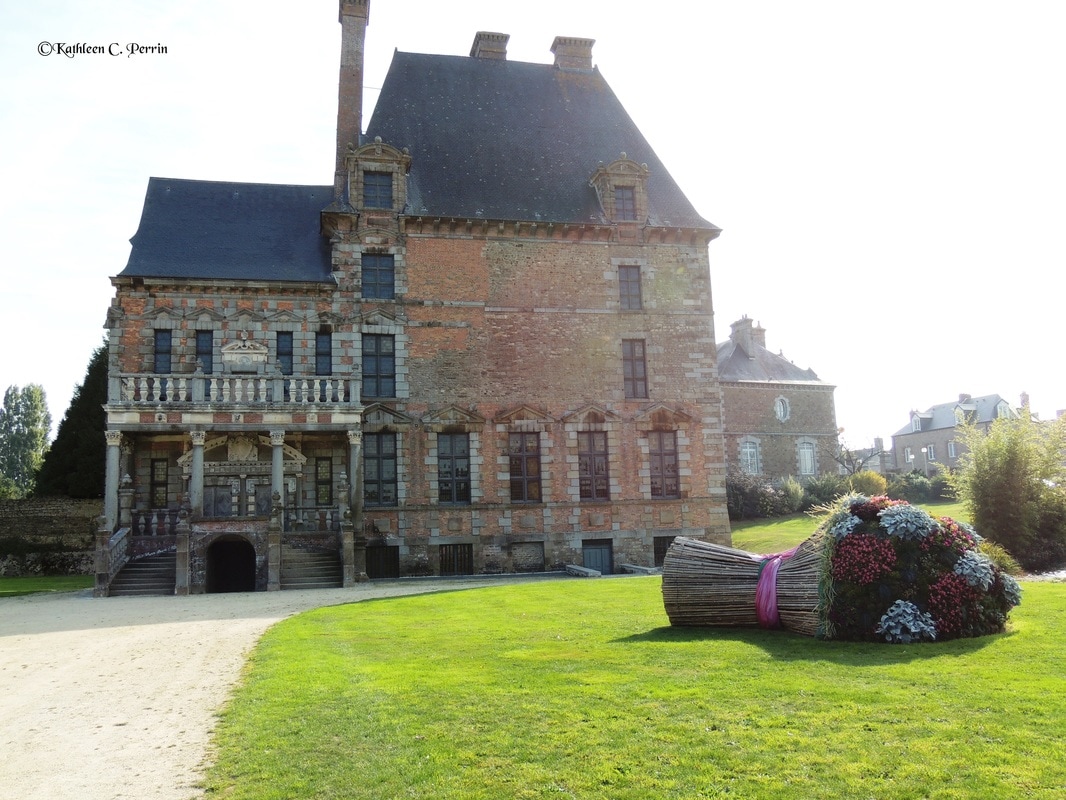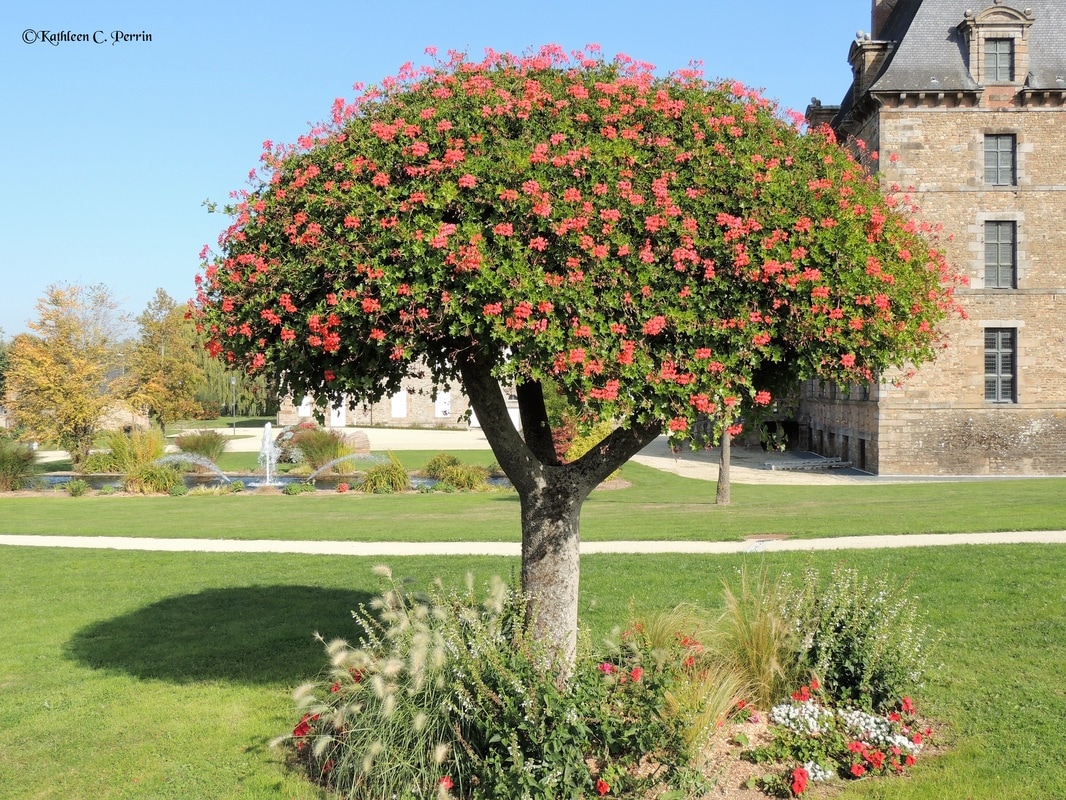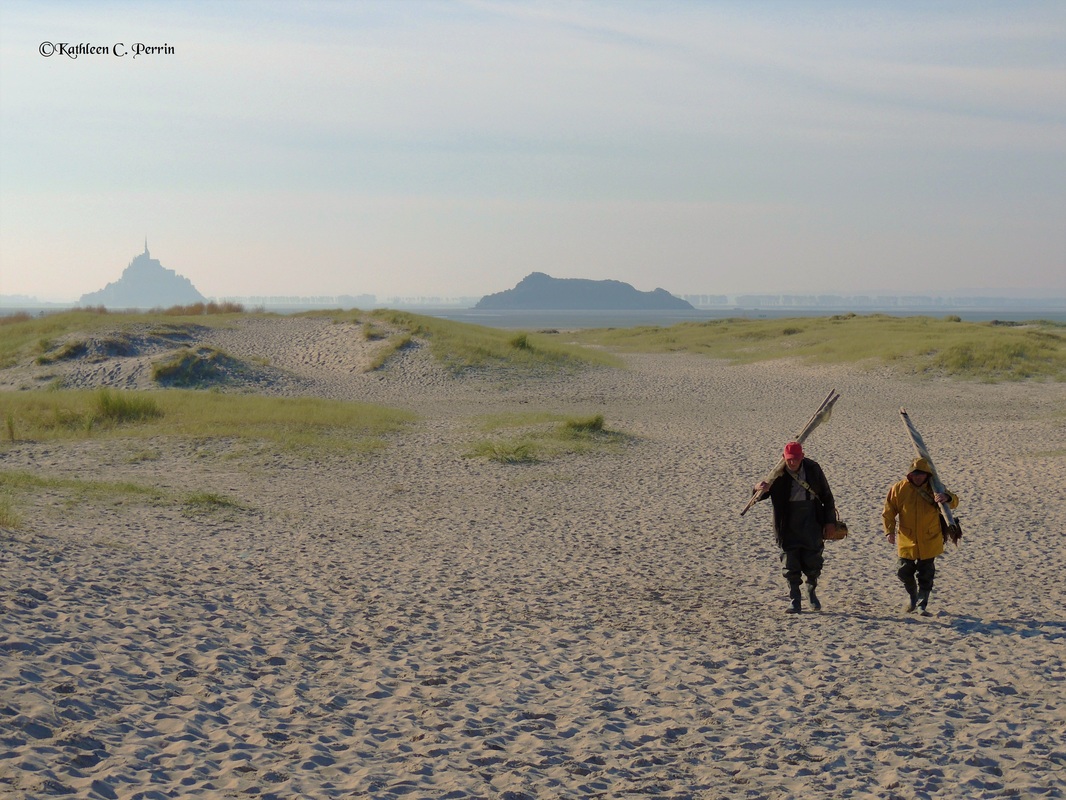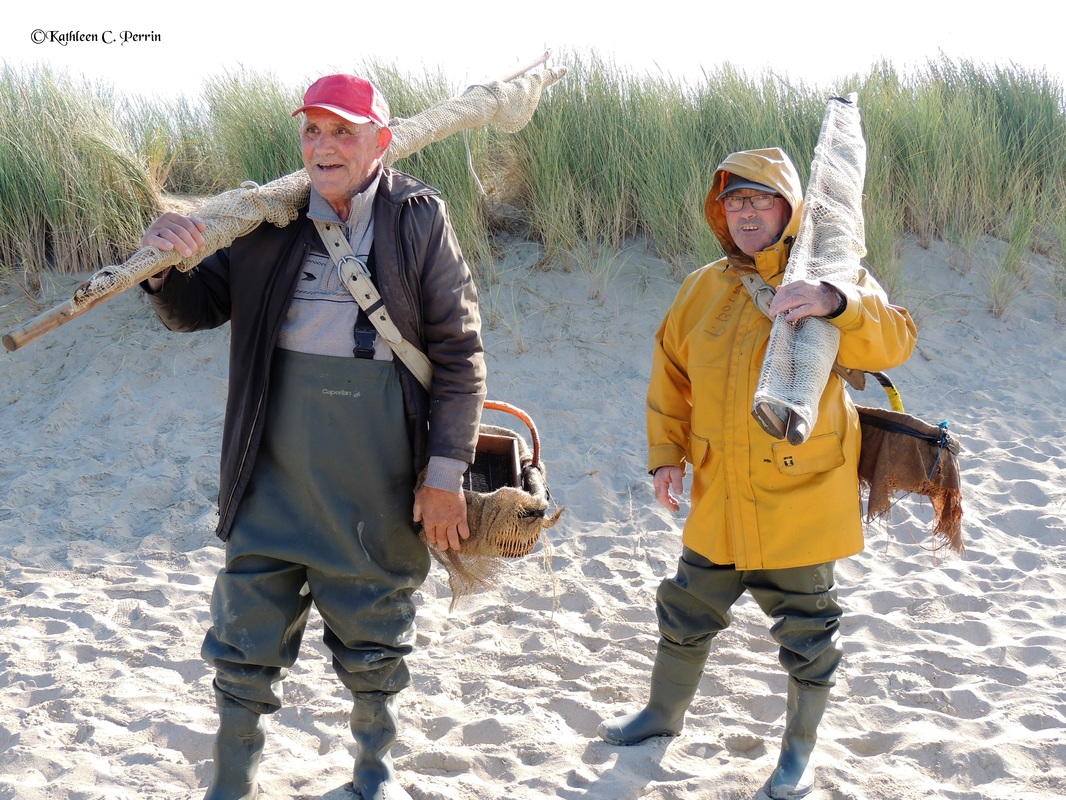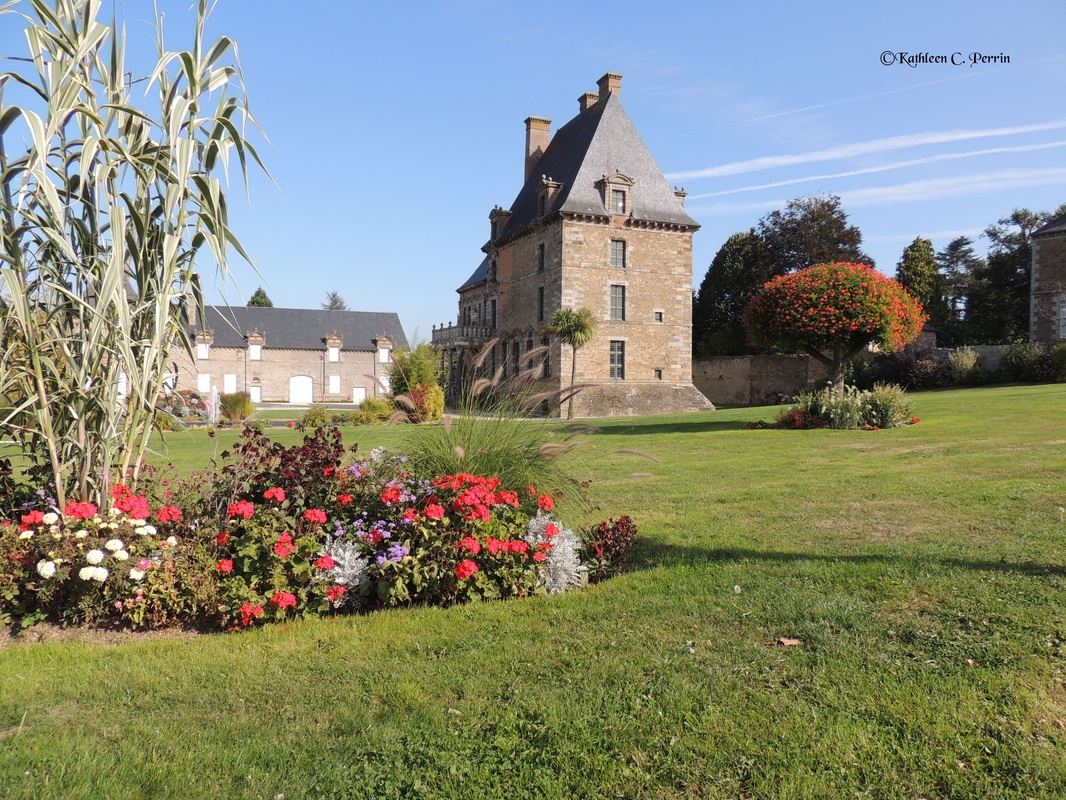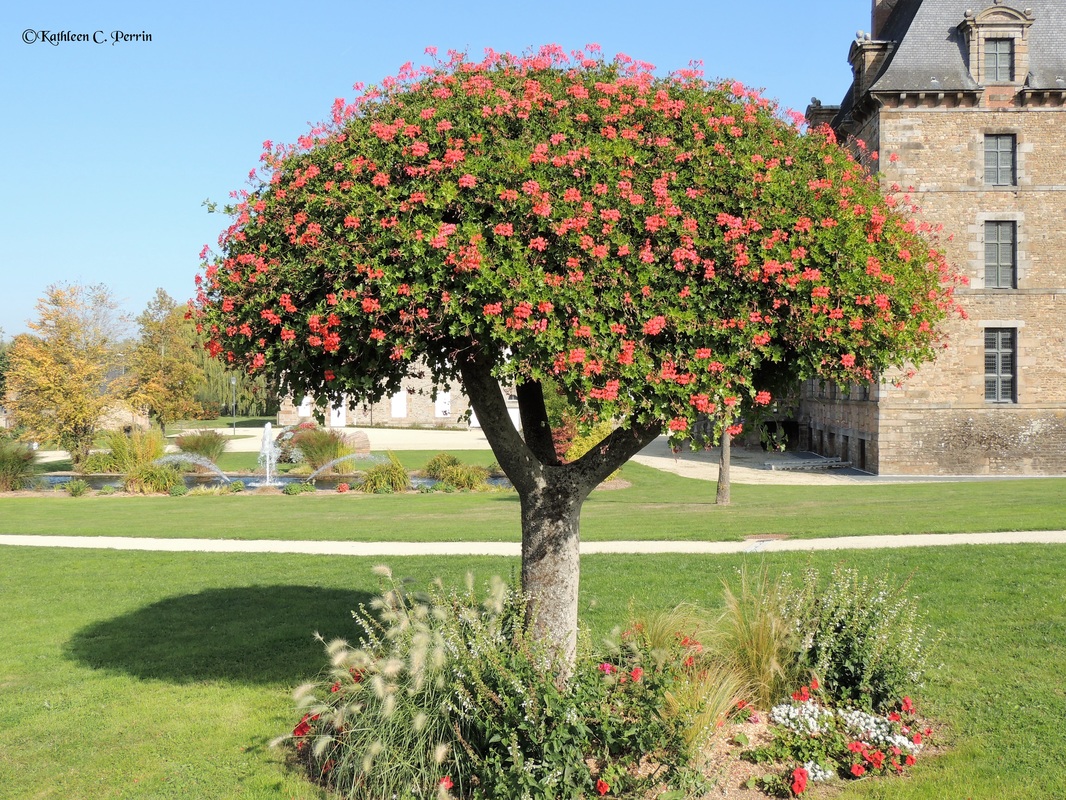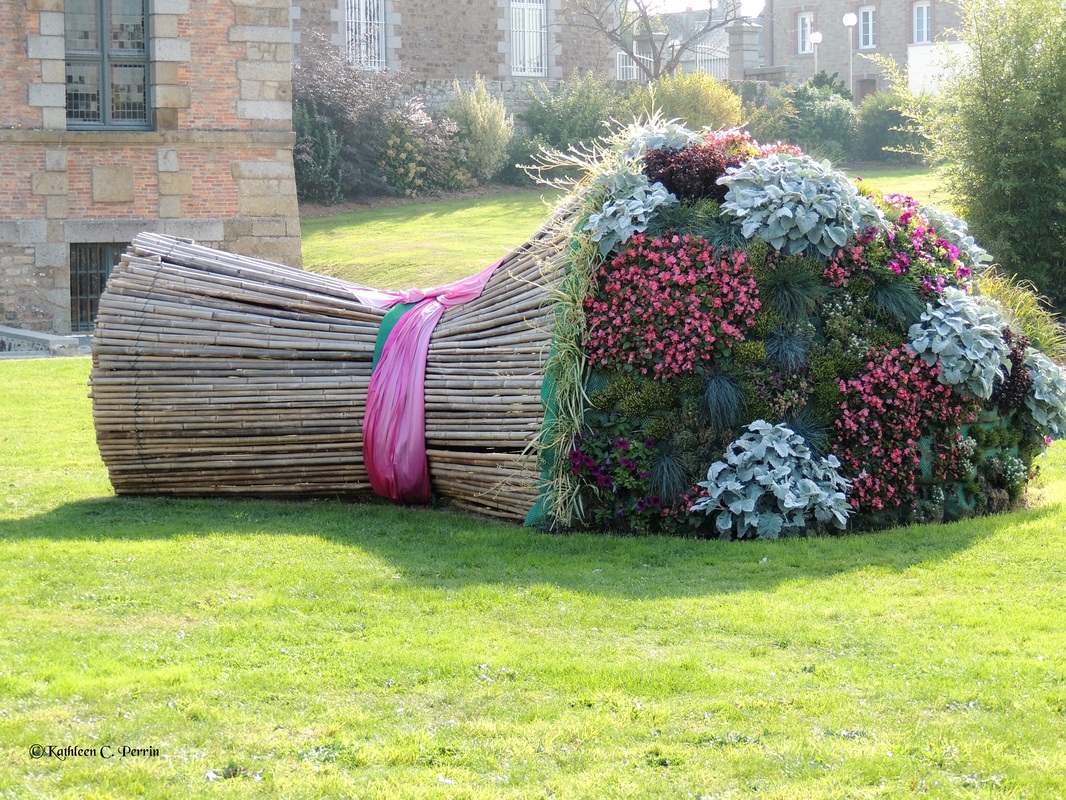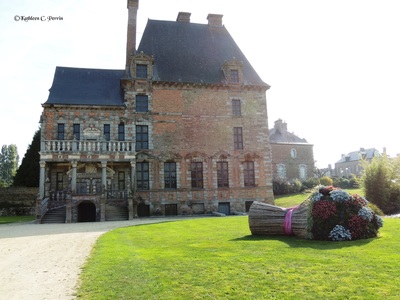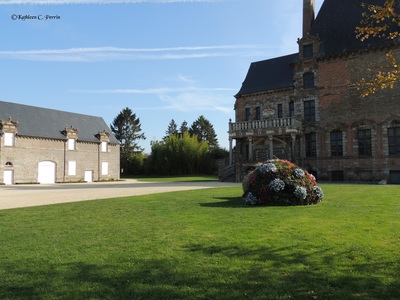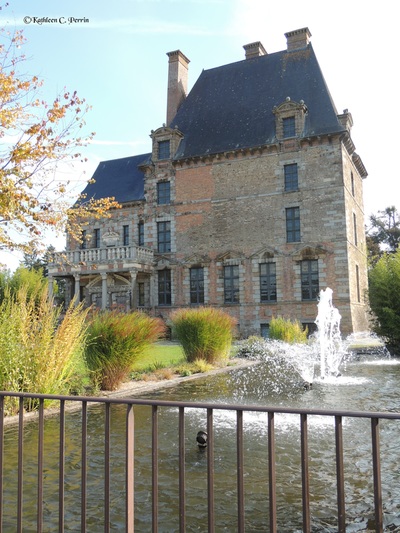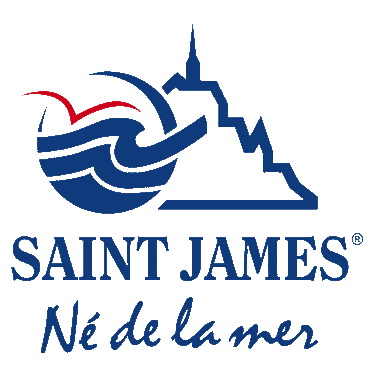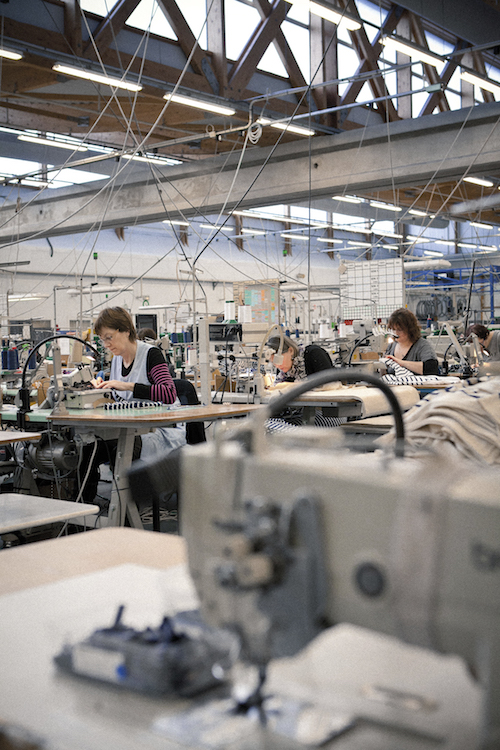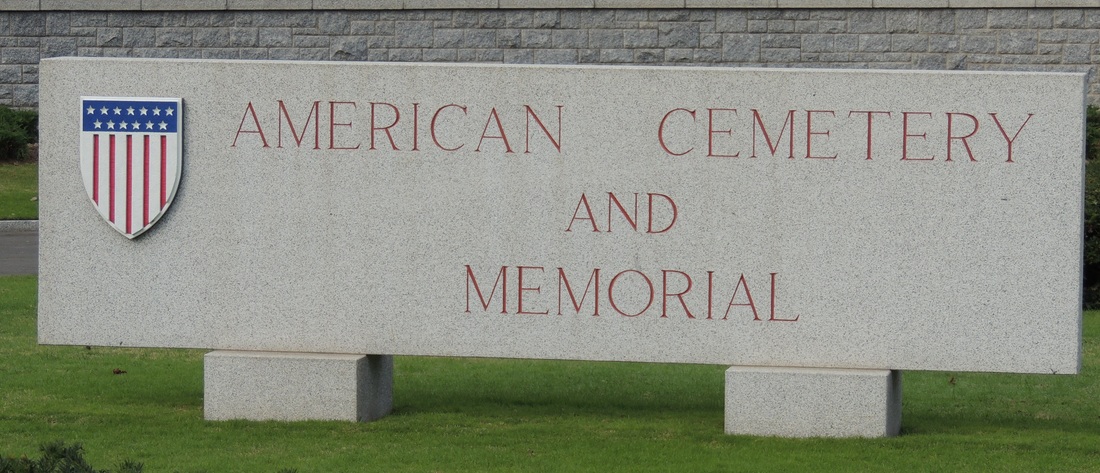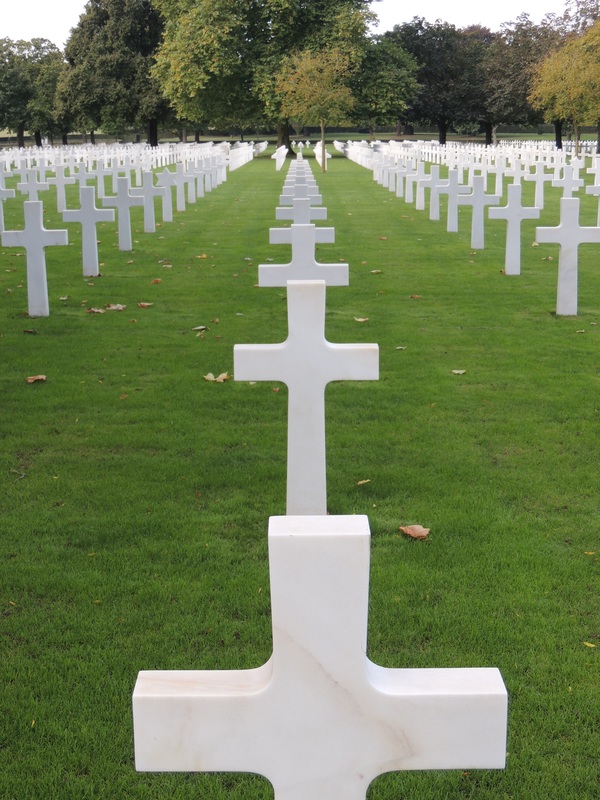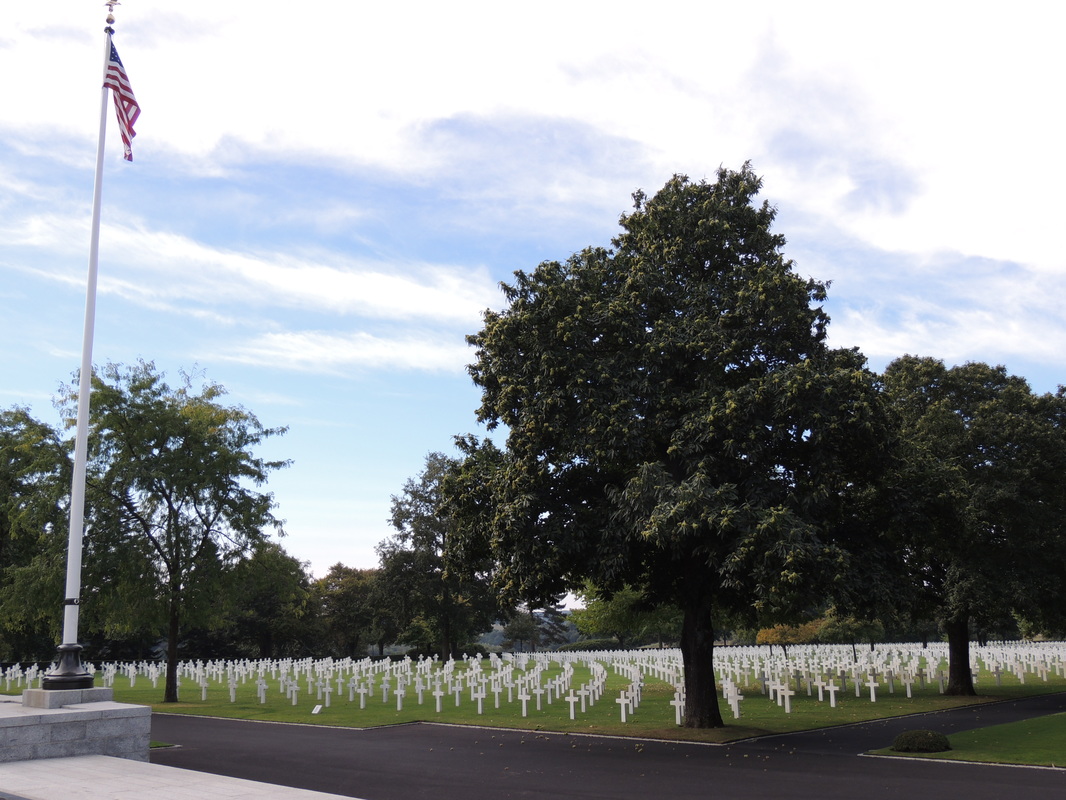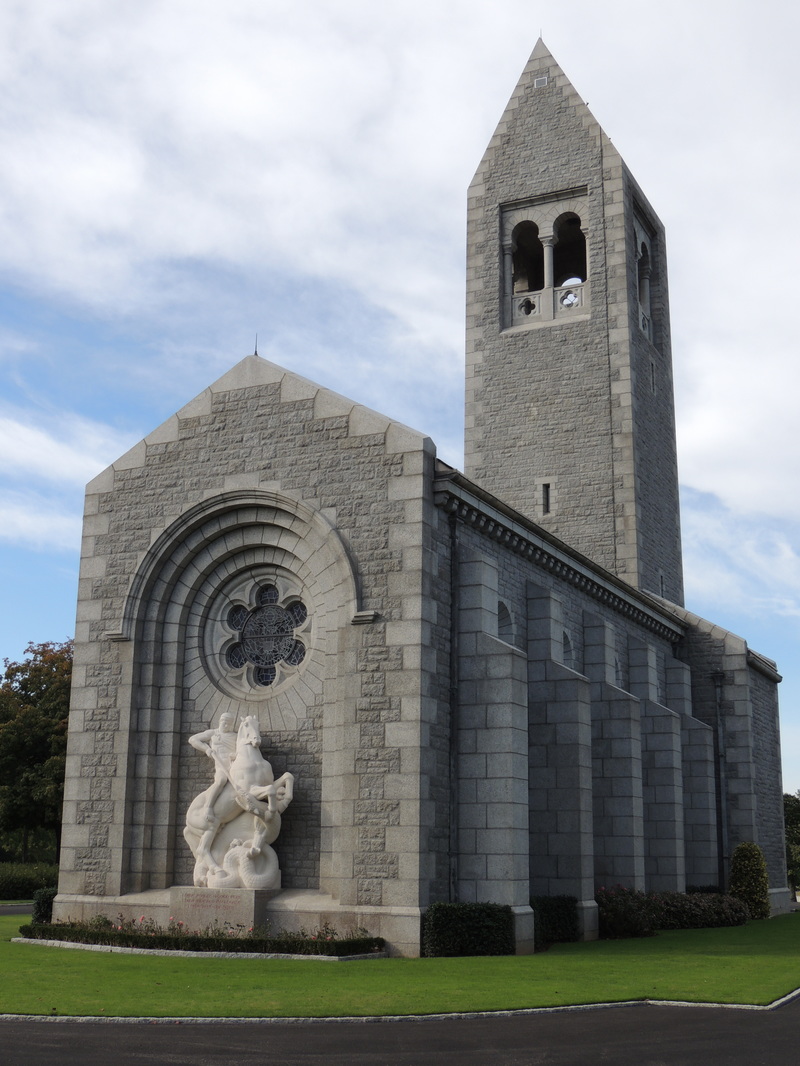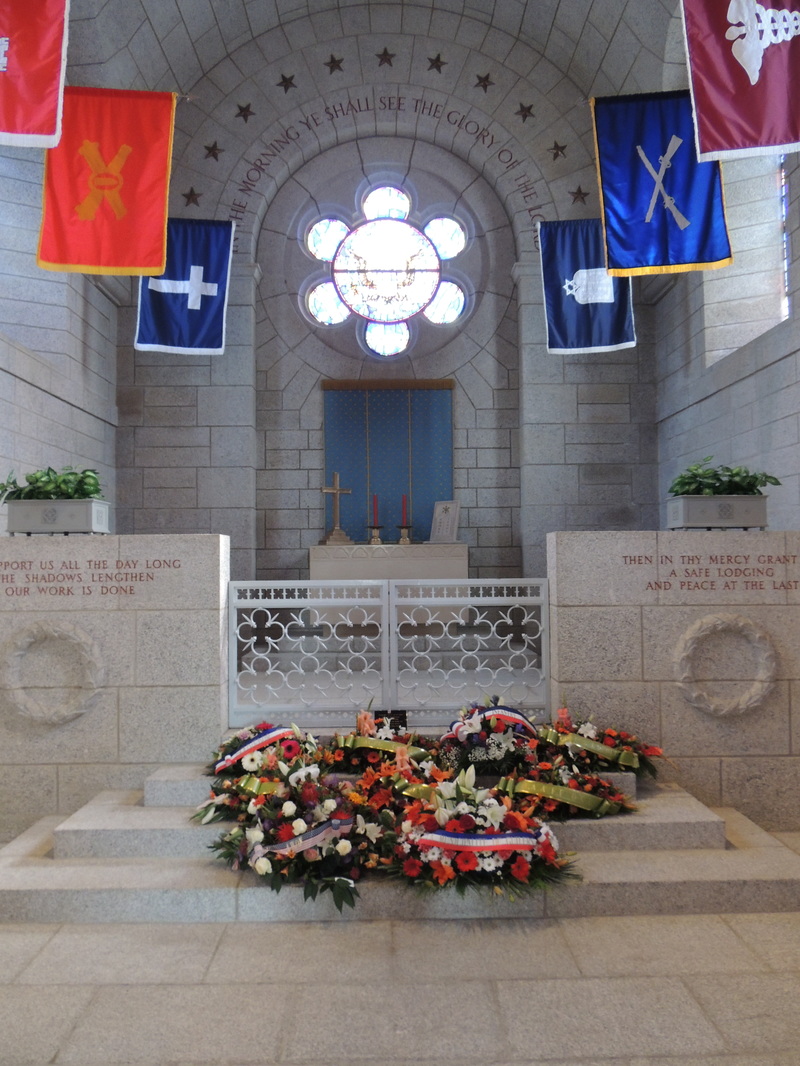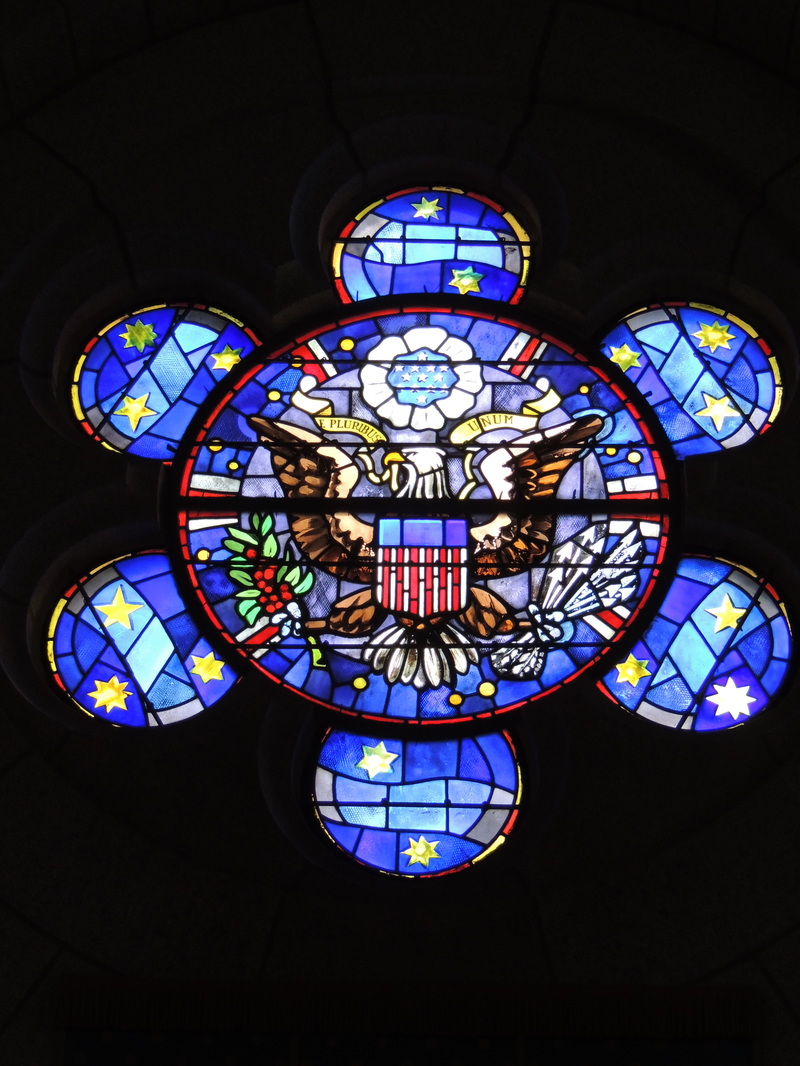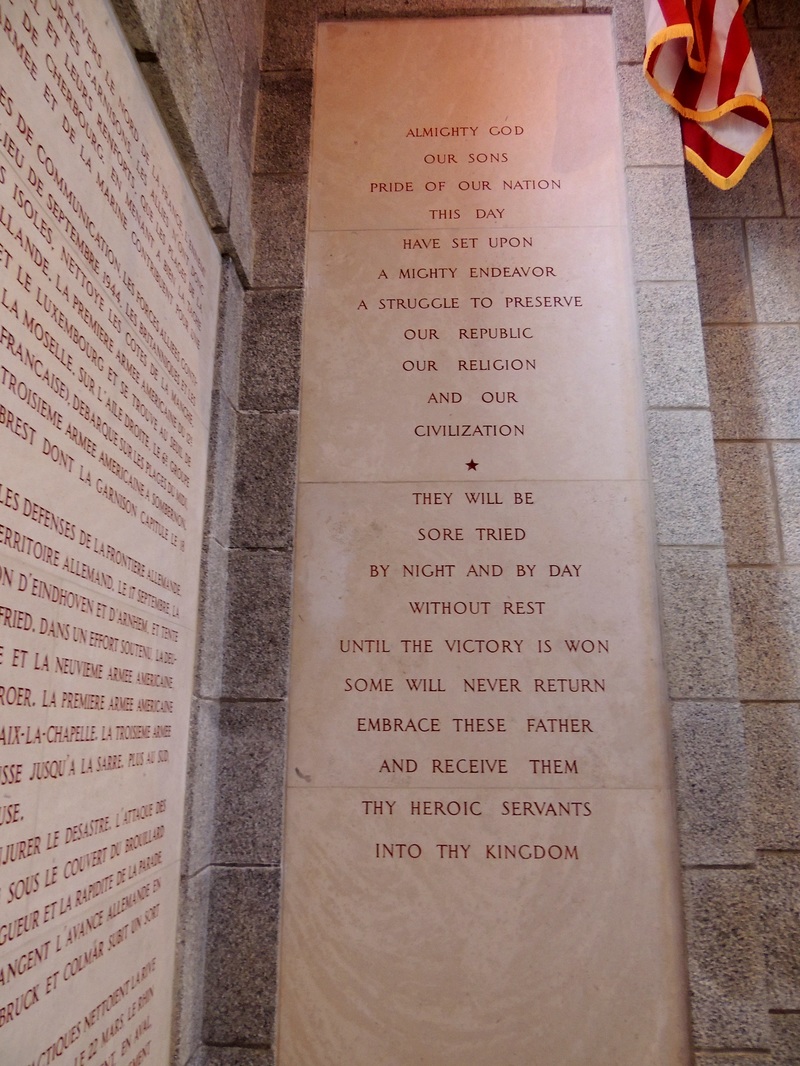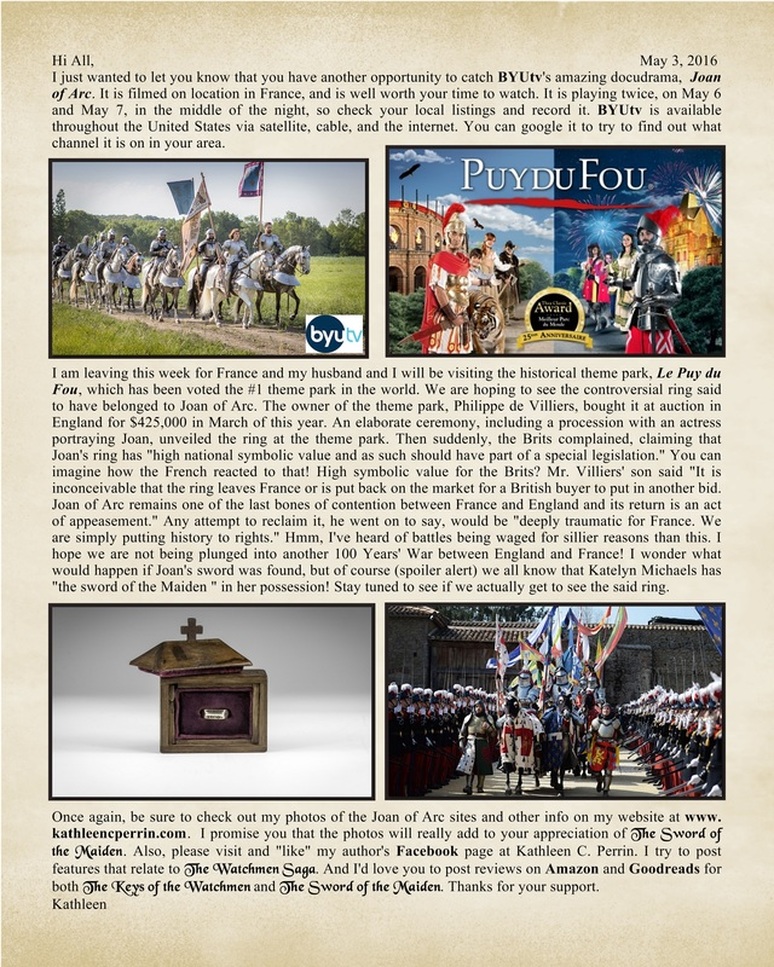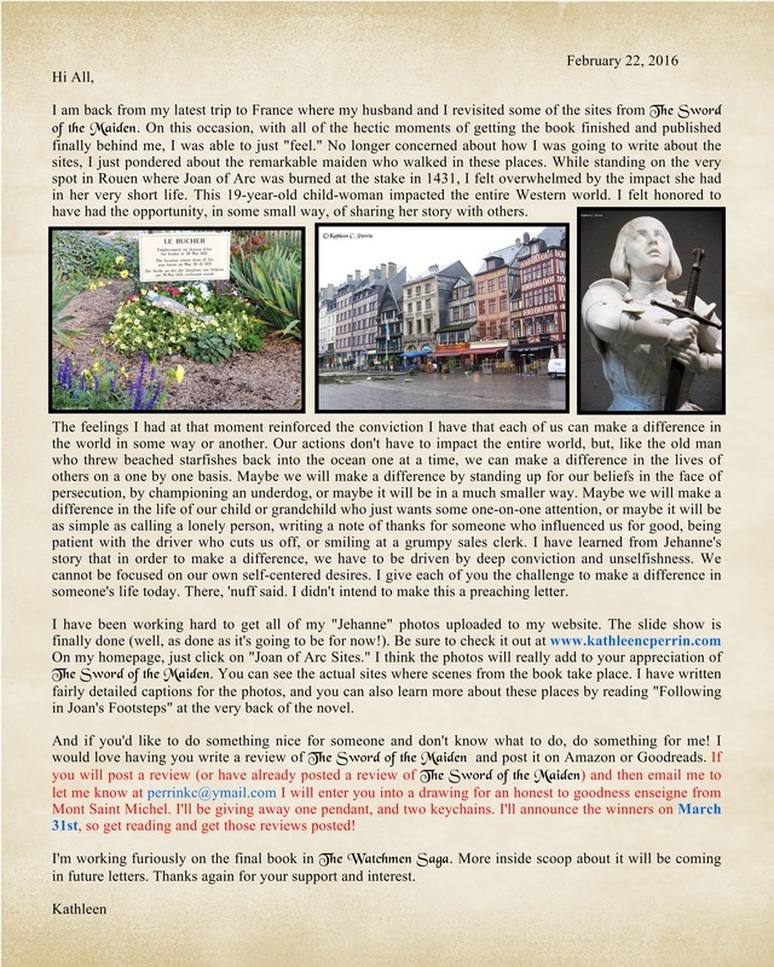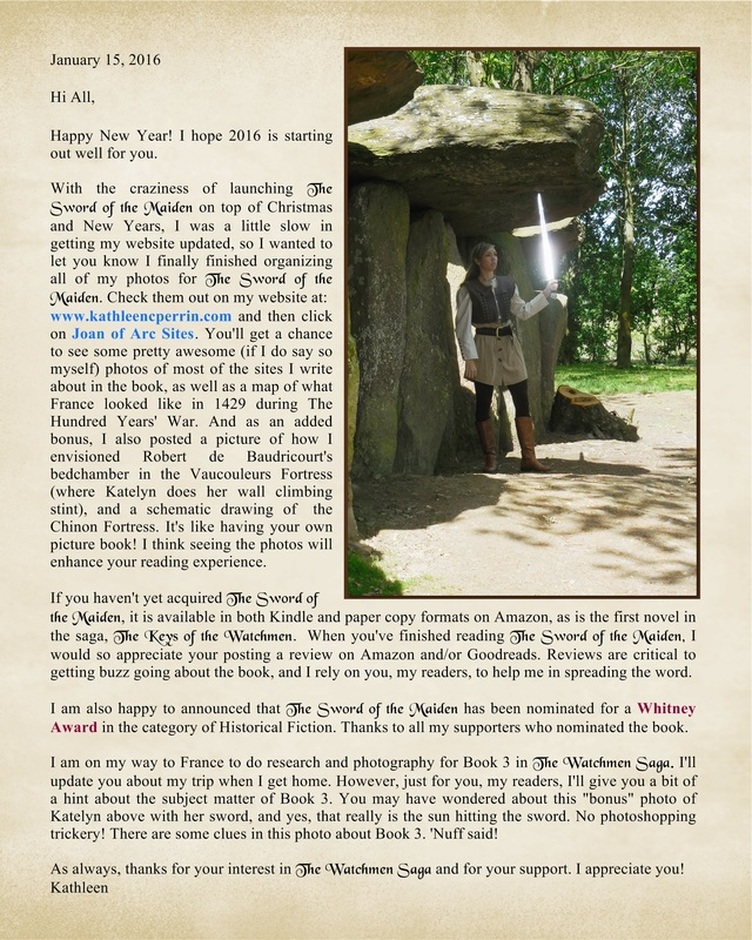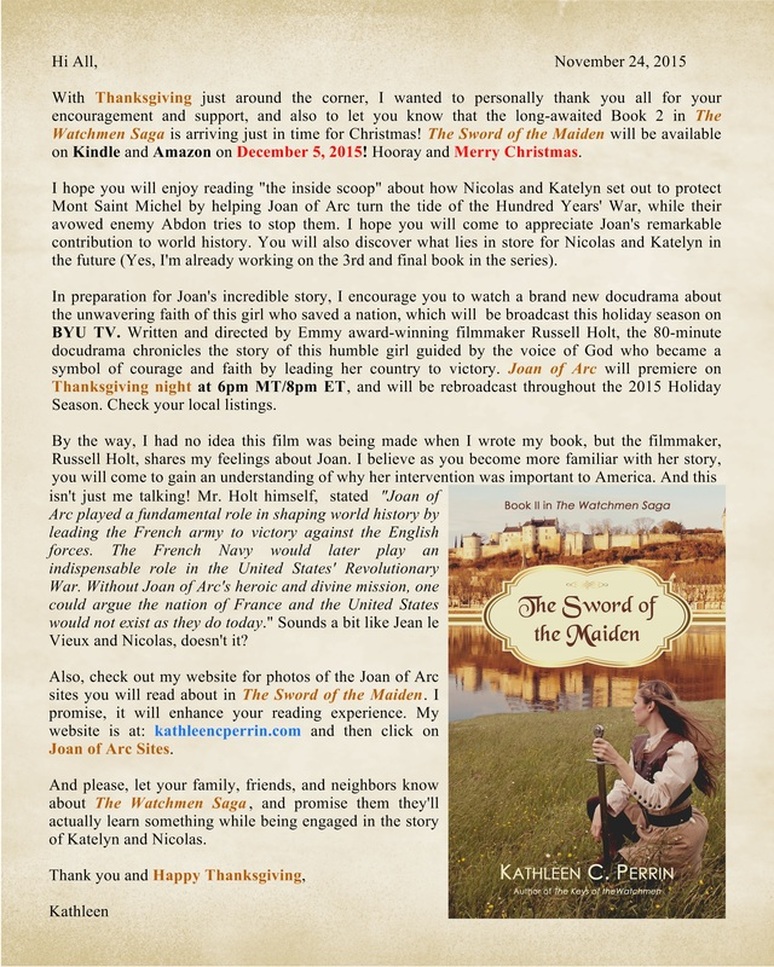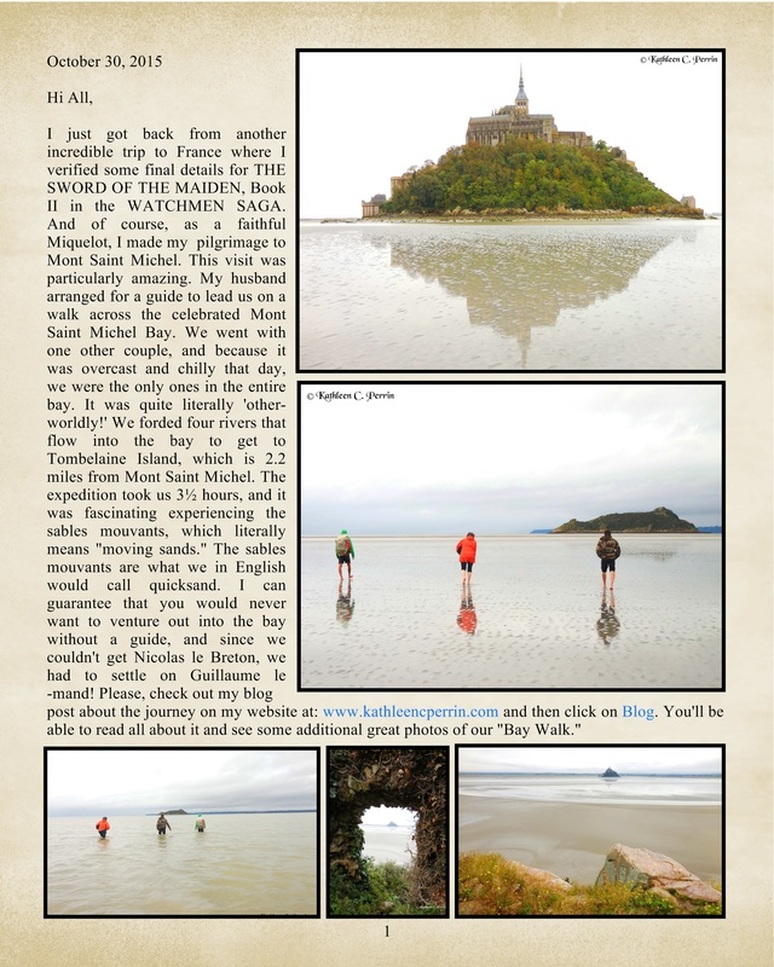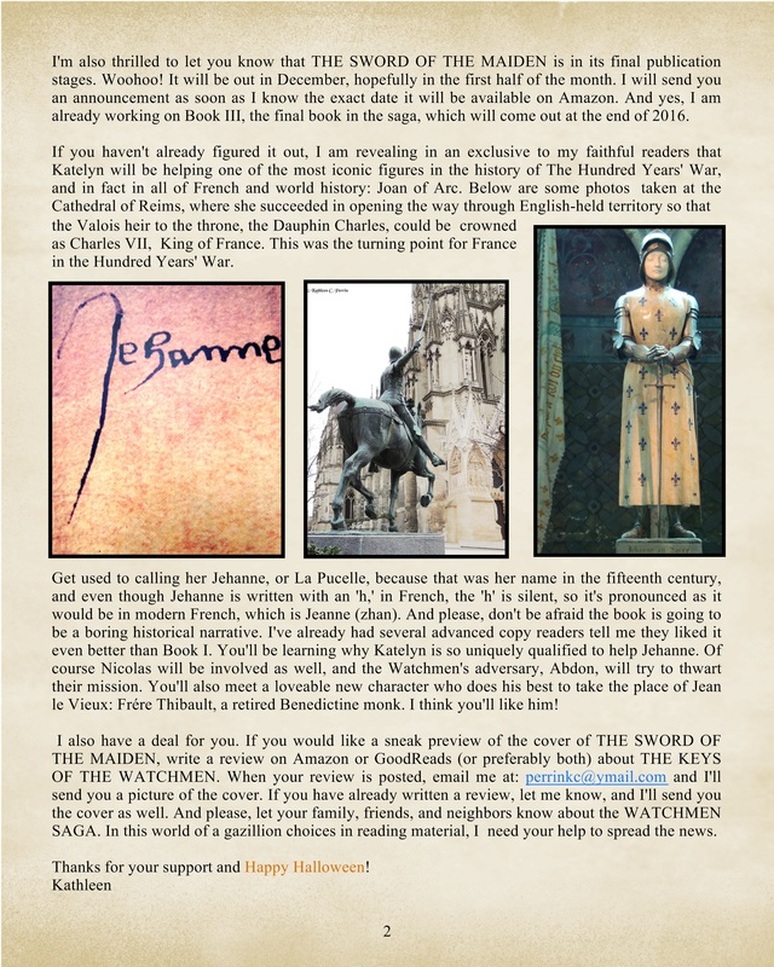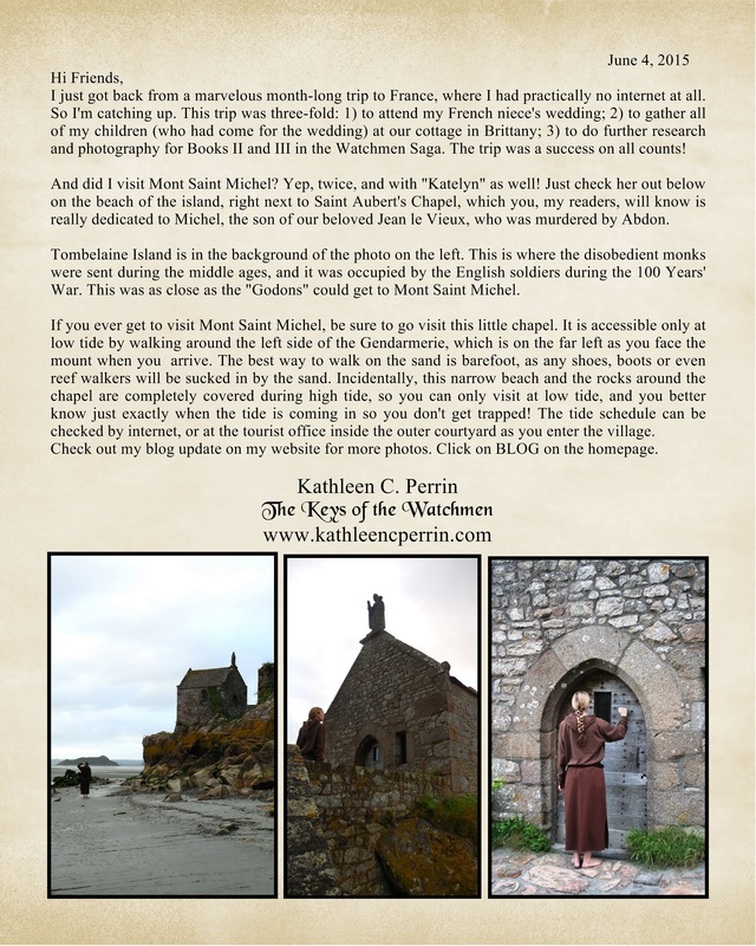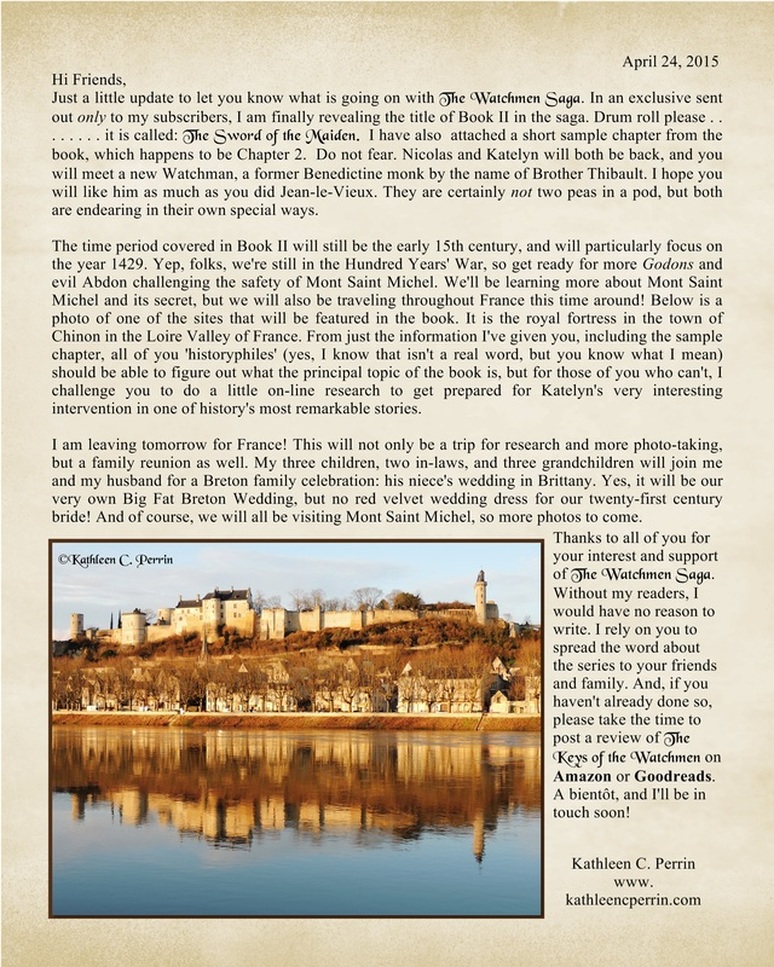The Watchmen Saga Newsletters
August 2018
I’m sure you have been wondering where I've been and where my promised book for 2018 is. Well, life has taken an unexpected turn for me and my husband, which has changed my plans for the next several years.
Let me back up a bit and set this up for you. Since my marriage, I have spent nearly eight years with my husband in Tahiti. Tahiti is actually the main island of about 130 islands making up the Overseas Territory of French Polynesia belonging to France. My first stint in French Polynesia was after the birth of our first child when my husband was doing research for his doctorate in International Educational Development from Columbia University. Our next stint was for four years when my husband was the principal of a private school (where I taught an intensive English course). Our next adventure there was three years as missionaries for our Church, and in March of this year, we were once again called by our Church leaders to return to Tahiti in October for another three years of voluntary service in the Tahiti Papeete Temple. We have spent the last few months making arrangements and preparing for this big change, which has put a halt to my writing. We are overwhelmed with this new assignment but we’re also looking forward to returning and serving among wonderful people we know and love.
One of the results of this calling is that I will not be publishing anything until our service is completed, so I will be taking a leave of absence from my writing career for the next three-plus years. I want to thank you all for the support you have given me, and I truly hope to get back to writing after our return in late 2021. I do have two novels nearly finished, so my plan is to get them published after my return. This also means I will not be writing any more newsletters, although I will regularly update the blog on this website (http://www.kathleencperrin.com/blog or go to http://www.kathleencperrin.com then click on “more” and then on “BLOG”).
My husband and I took a farewell trip to France in June and July and returned with some wonderful experiences and adventures. I have just posted two entries on my blog about the Dordogne River Valley (beautiful villages and prehistoric cave art), so check them out. I will also be posting more in the next few weeks, including an account of our adventure of attending four stages of the most famous bike race in the world, the TOUR DE FRANCE. Yes, we have been Tour de France fans for years. Then I’ll post about Tahiti from time to time, so check in once in a while and perhaps you’ll learn something interesting about French Polynesia!
Once again, thanks to all of you for your incredible support of THE WATCHMEN SAGA. For those of you who will still have the same email addresses in three or so years, you may be hearing from me again.
Adieu et bon courage à tous,
Kathleen
Let me back up a bit and set this up for you. Since my marriage, I have spent nearly eight years with my husband in Tahiti. Tahiti is actually the main island of about 130 islands making up the Overseas Territory of French Polynesia belonging to France. My first stint in French Polynesia was after the birth of our first child when my husband was doing research for his doctorate in International Educational Development from Columbia University. Our next stint was for four years when my husband was the principal of a private school (where I taught an intensive English course). Our next adventure there was three years as missionaries for our Church, and in March of this year, we were once again called by our Church leaders to return to Tahiti in October for another three years of voluntary service in the Tahiti Papeete Temple. We have spent the last few months making arrangements and preparing for this big change, which has put a halt to my writing. We are overwhelmed with this new assignment but we’re also looking forward to returning and serving among wonderful people we know and love.
One of the results of this calling is that I will not be publishing anything until our service is completed, so I will be taking a leave of absence from my writing career for the next three-plus years. I want to thank you all for the support you have given me, and I truly hope to get back to writing after our return in late 2021. I do have two novels nearly finished, so my plan is to get them published after my return. This also means I will not be writing any more newsletters, although I will regularly update the blog on this website (http://www.kathleencperrin.com/blog or go to http://www.kathleencperrin.com then click on “more” and then on “BLOG”).
My husband and I took a farewell trip to France in June and July and returned with some wonderful experiences and adventures. I have just posted two entries on my blog about the Dordogne River Valley (beautiful villages and prehistoric cave art), so check them out. I will also be posting more in the next few weeks, including an account of our adventure of attending four stages of the most famous bike race in the world, the TOUR DE FRANCE. Yes, we have been Tour de France fans for years. Then I’ll post about Tahiti from time to time, so check in once in a while and perhaps you’ll learn something interesting about French Polynesia!
Once again, thanks to all of you for your incredible support of THE WATCHMEN SAGA. For those of you who will still have the same email addresses in three or so years, you may be hearing from me again.
Adieu et bon courage à tous,
Kathleen
December 2017
As Christmas approaches, I thought I would share with you one of my passions. My husband and I collect nativities . . . manger scenes, crèches, nacimientos, nascitas, Weihnachtskrippen . . . whatever you chose to call them. Because of my husband’s employment, and because of our passion for travel, we have had the privilege of exploring the world. Everywhere we have gone, we have searched for original, handcrafted nativities, even in non-Christian countries. In fact, some of our most unique nativities come from non-Christian countries. Pieces from our collection have been displayed in museums, private displays, and even at the Utah State governor’s mansion.
But of all our amazing nativities, my very favorite is the one that started the entire chain of collecting folly. It is the French santon nativity given to my husband at his birth by his uncle many decades ago (I won’t tell you exactly how many decades!) It contains nearly fifty pieces, and it is the center of our annual Christmas celebration. Over the years, it has traveled from France to America and has been battered and worn, but it has also been loved and cherished. When our children were young, it was a family event for the kids to carefully unroll the tissue-wrapped figures and place them in the display one by one. Traditionally, Baby Jesus isn’t supposed to appear in the French crèche until Christmas morning, and the Wise Men don’t appear until Epiphany or Three Kings’ Day, on January 6th, but not in our home. The children couldn’t wait that long. As soon as Thanksgiving was over, they vied to find the figure of baby Jesus and place him inside the stable. They also hoped to be the ones to find Mary, Joseph, the Wise Men, the angel, (placed on top of the stable), and even the thief, who was always placed with his back to the Holy Family. Today, the tradition of setting up the crèche has evolved into having any of our grandchildren in town help us unwrap our beloved santons (photo above).
The santons (or little saints) originate from Southern France, the area known as Provence. All nativity scenes originally stem from the first living Nativity, said to have been created in 1223 by St. Francis, near Assisi, Italy. In France, when the living nativity scene evolved into permanent manger scenes, they were made of painted and gilded wood and displayed in Catholic churches throughout the country. In time, the scenes became luxury artifacts collected by aristocratic French families as status symbols. During the French Wars of Religion (the setting for The Secret of the Abbey), the manger figures served to combat the Protestant Reformation from the Catholic point of view, but were originally viewed by the Huguenots as disturbing symbols of Catholic idolatry. Two centuries later, at the time of the French Revolution, the pious scenes were banned not because of conflicting religious interpretations, but for purely secular reasons. Churches were burned and closed by anti-clerical revolutionaries, and the hated icons were destroyed. It was at this point that French commoners started making nativity scenes secretly in their homes, made from wood, bits of fabric, and other natural materials. Such an undertaking was audacious and daring with the threat of Madame la Guillotine constantly looming over the faithful folk.
By 1797, with the fervid anti-religion sentiment in check, an artisan in Marseille by the name of Jean-Louis Lagnel started molding small figures out of clay, which ordinary people could affordable. The word “santon” was not used until 1826, four years after Lagnel’s death. In the 20th century, Thérèse Neveu from Aubagne, a small town north of Marseille, began to fire the clay figures, making them more resistant. And thus, the “santonnier” (santon maker) came into existence.
Ironically, the santon was a child of the French Revolution, because it was egalitarian in nature. In addition to the traditional crèche figures (Holy Family, angels, magi and shepherds) the nativity of Southern France included figures that represented the typical inhabitants of post-Revolution Provence: commoners of all walks of life, and no royalty except for the kingly Magi. It was a religious scene incorporated into a secular world, and for a time antagonized both the Church and the Republic. The Church tolerated it as trivial entertainment for children, and the Republic, which attempted in all ways to create a homogenous and secular France, frowned upon it as a subversive expression of regional identity and religious fervor.
But the people, if not the Church or State, loved the little figures, which were soon sold in fairs and shops throughout Provence. The number of santonniers increased, with ensuing competitions to crown the best santonnier each year (Meilleur Ouvrier de France), and currently, santons are made in every imaginable size, including the puces (2 cm high) to well over a foot tall. The larger figures are dressed in elaborate fabric clothing, and the smaller santons are simply hand-painted, but all portray the authentic manner of life and dress of 19th-century Provence.
Today, hundreds of santonniers work all over Southern France, and have even spread to other regions, including Brittany, where Breton santonniers create typical inhabitants of Breton villages, with sailors, fishermen and fishmongers. However, the traditional Provençal crèche is the classic French crèche and remains a mirror of a 19th-century Provençal village with such figures as the miller carrying his sack of flour on a donkey, the farmer’s wife with her basket of eggs, the schoolmistress, the farandole dancers, the thief with knife in hand, and Monsieur le Maire and Monsieur le Curé, all anachronistically revering Christ’s birth in Palestine, thousands of miles away and years earlier.
It has been a delight for me to embrace the wonder of the nativity scene from all cultural settings, and from the French perspective in particular. Whether you are a Christian or not, the history of the nativity scene is a fascinating study of artisanship and a wondrous embodiment of the individual expression of faith. Each country, and in fact, each artist, has a story to tell, and I have heard many of them. These stories and our collection of nativities have not only brought joy and beauty into our home but have increased our love for the Christmas season. This love has also motivated me each Christmas to pen a poem based on the story and figures of the nativity, (some of which are posted under "Christmas Poems" under "more" on this website. You will find 2017's poem below for your perusal.
I wish all of you a wonderful holiday season and a happy and healthy 2018.
The santons (or little saints) originate from Southern France, the area known as Provence. All nativity scenes originally stem from the first living Nativity, said to have been created in 1223 by St. Francis, near Assisi, Italy. In France, when the living nativity scene evolved into permanent manger scenes, they were made of painted and gilded wood and displayed in Catholic churches throughout the country. In time, the scenes became luxury artifacts collected by aristocratic French families as status symbols. During the French Wars of Religion (the setting for The Secret of the Abbey), the manger figures served to combat the Protestant Reformation from the Catholic point of view, but were originally viewed by the Huguenots as disturbing symbols of Catholic idolatry. Two centuries later, at the time of the French Revolution, the pious scenes were banned not because of conflicting religious interpretations, but for purely secular reasons. Churches were burned and closed by anti-clerical revolutionaries, and the hated icons were destroyed. It was at this point that French commoners started making nativity scenes secretly in their homes, made from wood, bits of fabric, and other natural materials. Such an undertaking was audacious and daring with the threat of Madame la Guillotine constantly looming over the faithful folk.
By 1797, with the fervid anti-religion sentiment in check, an artisan in Marseille by the name of Jean-Louis Lagnel started molding small figures out of clay, which ordinary people could affordable. The word “santon” was not used until 1826, four years after Lagnel’s death. In the 20th century, Thérèse Neveu from Aubagne, a small town north of Marseille, began to fire the clay figures, making them more resistant. And thus, the “santonnier” (santon maker) came into existence.
Ironically, the santon was a child of the French Revolution, because it was egalitarian in nature. In addition to the traditional crèche figures (Holy Family, angels, magi and shepherds) the nativity of Southern France included figures that represented the typical inhabitants of post-Revolution Provence: commoners of all walks of life, and no royalty except for the kingly Magi. It was a religious scene incorporated into a secular world, and for a time antagonized both the Church and the Republic. The Church tolerated it as trivial entertainment for children, and the Republic, which attempted in all ways to create a homogenous and secular France, frowned upon it as a subversive expression of regional identity and religious fervor.
But the people, if not the Church or State, loved the little figures, which were soon sold in fairs and shops throughout Provence. The number of santonniers increased, with ensuing competitions to crown the best santonnier each year (Meilleur Ouvrier de France), and currently, santons are made in every imaginable size, including the puces (2 cm high) to well over a foot tall. The larger figures are dressed in elaborate fabric clothing, and the smaller santons are simply hand-painted, but all portray the authentic manner of life and dress of 19th-century Provence.
Today, hundreds of santonniers work all over Southern France, and have even spread to other regions, including Brittany, where Breton santonniers create typical inhabitants of Breton villages, with sailors, fishermen and fishmongers. However, the traditional Provençal crèche is the classic French crèche and remains a mirror of a 19th-century Provençal village with such figures as the miller carrying his sack of flour on a donkey, the farmer’s wife with her basket of eggs, the schoolmistress, the farandole dancers, the thief with knife in hand, and Monsieur le Maire and Monsieur le Curé, all anachronistically revering Christ’s birth in Palestine, thousands of miles away and years earlier.
It has been a delight for me to embrace the wonder of the nativity scene from all cultural settings, and from the French perspective in particular. Whether you are a Christian or not, the history of the nativity scene is a fascinating study of artisanship and a wondrous embodiment of the individual expression of faith. Each country, and in fact, each artist, has a story to tell, and I have heard many of them. These stories and our collection of nativities have not only brought joy and beauty into our home but have increased our love for the Christmas season. This love has also motivated me each Christmas to pen a poem based on the story and figures of the nativity, (some of which are posted under "Christmas Poems" under "more" on this website. You will find 2017's poem below for your perusal.
I wish all of you a wonderful holiday season and a happy and healthy 2018.
Swaddling Clothes
Kathleen C. Perrin - December 2017 ©
Kathleen C. Perrin - December 2017 ©
Son of God, His Holy Lamb, a babe in swaddling bands,
Wrapped, no doubt, with wedding strips by Mary’s gentle hands.[1]
A sign to shepherds: swaddled babe, a manger as his bed,
Deep symbol of a firstborn lamb, unblemished hoof to head . . .
Designated sacrifice, kept in a manger hav’n,
Linen bands wrapped to protect from blemish until giv’n.[2]
In awe, the shepherds came and found the Firstborn Son of God.
None failed to understand the sign, and spread the news abroad.
Greater meaning, bands of cloth, when wrapped about a reed
And soaked in oil, act as a torch to light a world in need.
Christ, with holy oil anointed, filled the world with Light,
Like the star that lit the sky upon that holy night.
Other use of bands of cloth: binding wounds and breaks.
The Savior came to bind our wounds, was wounded for our sakes.
He broke the bonds of sin and then was bound by guards and jailed,
E’en though he could have broken free, then on a cross, was nailed.
Strips of cloth were wound about his body in the grave.
Then left, a sign he broke the bands of death to mankind save.
___________________
[1] In Jewish tradition, the hands of the bride and groom were bound under the wedding canopy with strips of cloth embroidered with symbols of their lineage. It was a common practice to use those same strips to swaddle their firstborn child.
[2] Jewish shepherds offered the firstborn of the flock as a sin sacrifice offering. To prevent the newborn lamb from injuring itself so it would be without blemish, the shepherds would often wrap the firstborn lamb in bands of cloth and place it in a food trough apart from the other sheep until it was stronger and could go to its mother until it was time to be offered as a sacrifice.
Wrapped, no doubt, with wedding strips by Mary’s gentle hands.[1]
A sign to shepherds: swaddled babe, a manger as his bed,
Deep symbol of a firstborn lamb, unblemished hoof to head . . .
Designated sacrifice, kept in a manger hav’n,
Linen bands wrapped to protect from blemish until giv’n.[2]
In awe, the shepherds came and found the Firstborn Son of God.
None failed to understand the sign, and spread the news abroad.
Greater meaning, bands of cloth, when wrapped about a reed
And soaked in oil, act as a torch to light a world in need.
Christ, with holy oil anointed, filled the world with Light,
Like the star that lit the sky upon that holy night.
Other use of bands of cloth: binding wounds and breaks.
The Savior came to bind our wounds, was wounded for our sakes.
He broke the bonds of sin and then was bound by guards and jailed,
E’en though he could have broken free, then on a cross, was nailed.
Strips of cloth were wound about his body in the grave.
Then left, a sign he broke the bands of death to mankind save.
___________________
[1] In Jewish tradition, the hands of the bride and groom were bound under the wedding canopy with strips of cloth embroidered with symbols of their lineage. It was a common practice to use those same strips to swaddle their firstborn child.
[2] Jewish shepherds offered the firstborn of the flock as a sin sacrifice offering. To prevent the newborn lamb from injuring itself so it would be without blemish, the shepherds would often wrap the firstborn lamb in bands of cloth and place it in a food trough apart from the other sheep until it was stronger and could go to its mother until it was time to be offered as a sacrifice.
September 2017
Hi All,
Today, I thought I would give you an update on some of the recent renovation done and archaeological discoveries made at Mont Saint Michel, most of which I managed to witness firsthand! The projects made my photo-taking forays on the Mount a bit challenging.
In May 2016, my husband and I arrived at Mont Saint Michel and were shocked to see that the Archangel Michael, who sits some 160 meters above the rocky tidal island on the top of the abbey spire was not there! Yep, gone! Nada, nothing. We learned that the 520-kilo (1,150-pound) statue of the Archangel had been damaged by numerous lightening strikes and bad weather and had been removed from the abbey spire to be repaired and re-gilded in a specialized workshop in the French region of La Dordogne. The restoration project took two months and cost a half a million dollars. Artisans from the same foundry that produced the Statue of Liberty, stripped the statue down to its original copper, which was restored and then coated with protective paint. Then came the gold leafing – twice the amount used in the statue’s last renovation in 1987. Michael was remounted on the abbey spire on 26 May, 2016. Unfortunately, we had already left France and didn’t get to see that event witnessed by hundreds of tourists, but we were able to see Michael’s precarious journey to and from the abbey spire via helicopter on the internet. Check out these remarkable films:
https://www.youtube.com/watch?v=J_C-liiMvHk
https://www.francebleu.fr/infos/culture-loisirs/mont-st-michel-le-retour-de-l-archange-en-normandie-1464186482
Today, I thought I would give you an update on some of the recent renovation done and archaeological discoveries made at Mont Saint Michel, most of which I managed to witness firsthand! The projects made my photo-taking forays on the Mount a bit challenging.
In May 2016, my husband and I arrived at Mont Saint Michel and were shocked to see that the Archangel Michael, who sits some 160 meters above the rocky tidal island on the top of the abbey spire was not there! Yep, gone! Nada, nothing. We learned that the 520-kilo (1,150-pound) statue of the Archangel had been damaged by numerous lightening strikes and bad weather and had been removed from the abbey spire to be repaired and re-gilded in a specialized workshop in the French region of La Dordogne. The restoration project took two months and cost a half a million dollars. Artisans from the same foundry that produced the Statue of Liberty, stripped the statue down to its original copper, which was restored and then coated with protective paint. Then came the gold leafing – twice the amount used in the statue’s last renovation in 1987. Michael was remounted on the abbey spire on 26 May, 2016. Unfortunately, we had already left France and didn’t get to see that event witnessed by hundreds of tourists, but we were able to see Michael’s precarious journey to and from the abbey spire via helicopter on the internet. Check out these remarkable films:
https://www.youtube.com/watch?v=J_C-liiMvHk
https://www.francebleu.fr/infos/culture-loisirs/mont-st-michel-le-retour-de-l-archange-en-normandie-1464186482
Since that time, the Centre des Monuments Nationaux (The National Monuments Center or CMN) has been extra busy on the Mount, including a $2.3 million restoration project of the abbey’s cloister. Located 80 meters above sea level, “between the seas and the heavens,” the cloister garden is unique in all the world and has been compared to the Hanging Gardens of Babylon. Once again, we discovered the project was underway by visiting the Mount. I was disappointed when we took several grandchildren to the abbey earlier this year to find most of the cloister closed, including the large window on the west side that provides an unhindered view of the vast Mont Saint Michel Bay below.
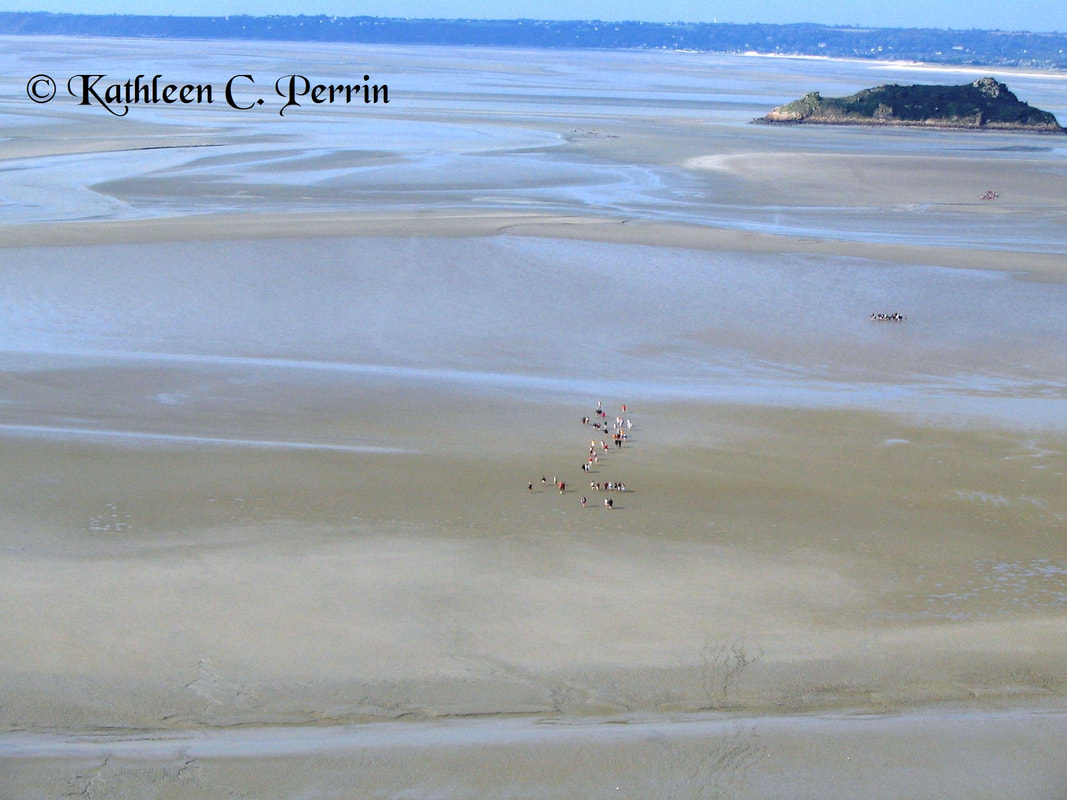
We learned that the work on the cloister commenced in January 2017 and has focused on making the cloister garden totally watertight. The Knights’ Hall (the original Scriptorium during the abbey’s period as the intellectual center of the West) had suffered significant water and mold damage due to water leaking through the ceiling from the garden sitting above it. The challenge for the project was to first remove some 50 tons of soil (40 cm or 16 inches deep). Although it seems crazy, the easiest way to do this ended up once again being by helicopter. It required 50 roundtrips. I’m not sure why they didn’t just pile up the soil on the West Terrace, but I guess they wanted to start with fresh dirt. I’m sure they know what they’re doing! After repairing and sealing the cement slab under the garden, new soil was brought in. In addition to the garden renovation, the floors of the four sides of the cloister surrounding it have been lowered by 17 to 25 cm (6-9 inches) to approach the pre-nineteenth-century level. This will allow the stones that frame the galleries to once again be used as benches. One of the side benefits of the cloister renovation is that the project has increased the CMN’s understanding of the very complex system of rainwater collection on the cloister roofs. For centuries, this rain water was used by the monks for their weekly washing of the feet ceremony.
According to the CMN’s chief architect, the cloister will be totally accessible to the public by mid-November of this year, although the restoration work on the garden won’t be complete until the spring of 2018. So if you are planning on visiting Mont Saint Michel in the next two months, be prepared for the disappointment of not seeing the entire cloister. Fortunately, the West Terrace (the scene of several exciting events in THE WATCHMEN SAGA) remains open and you can get an even better view of the bay from that vantage point.
On a completely different vein, one of the principal archaeological projects on the Mount got started quite by accident. While doing some updating of sewer and water lines under La Grande Rue (Main Street) of Mont Saint Michel last year, crews uncovered a section of the thirteenth-century cemetery at the foot of the parish Church of Saint Pierre (where Katelyn and Nicolas married), which extended underneath the cobblestones of the street, closing La Grande Rue for several months.
http://www.ouest-france.fr/normandie/manche/14-squelettes-decouverts-au-mont-saint-michel-4630787/
According to the CMN’s chief architect, the cloister will be totally accessible to the public by mid-November of this year, although the restoration work on the garden won’t be complete until the spring of 2018. So if you are planning on visiting Mont Saint Michel in the next two months, be prepared for the disappointment of not seeing the entire cloister. Fortunately, the West Terrace (the scene of several exciting events in THE WATCHMEN SAGA) remains open and you can get an even better view of the bay from that vantage point.
On a completely different vein, one of the principal archaeological projects on the Mount got started quite by accident. While doing some updating of sewer and water lines under La Grande Rue (Main Street) of Mont Saint Michel last year, crews uncovered a section of the thirteenth-century cemetery at the foot of the parish Church of Saint Pierre (where Katelyn and Nicolas married), which extended underneath the cobblestones of the street, closing La Grande Rue for several months.
http://www.ouest-france.fr/normandie/manche/14-squelettes-decouverts-au-mont-saint-michel-4630787/
Archaeologists from the French National Institute of Archaeological Research (INRAP), were brought in and the street was blocked off for several months. Originally, fourteen complete skeletons were found lined up on the ground, separated by stones, with their hands crossed over their stomachs, but eventually, a total of thirty graves were uncovered. And yes, I was also there during that phase, which required visitors to access the abbey from the ramparts. Sorry to all of you who visited during that time and were charged a fee to walk through certain shops to get to the ramparts outside! Extortion, I say. Someone always wants to profit from unusual circumstances and I don’t think the Archangel would approve of that pitiful money-making scheme.
http://www.la-croix.com/Sciences/Sciences/Decouverte-cimetiere-XIIIe-siecle-Mont-Saint-Michel-2017-01-27-1200820551
http://www.la-croix.com/Sciences/Sciences/Decouverte-cimetiere-XIIIe-siecle-Mont-Saint-Michel-2017-01-27-1200820551
In addition to finding the graves, the remains of the original thirteenth-century masonry gate and wall enclosing the village were also recently uncovered. During that period, the ramparts on the island were constructed, not at the bottom of the mount, but half-way up, surrounding a handful of village homes built directly onto the stone base of the Mount. Other homes were built below the fortifications, and must have been unlucky during enemy raids! This fortification wall was probably built by the abbot Richard Turstin in about 1256, replacing a wooden wall destroyed by a fire in 1204 set by attacking Bretons trying to regain control of the abbey.
In recent years, INRAP has also uncovered some other treasures, including the remains of the Tour Denis, erected in 1479 and destroyed in 1732, and some ancient homes destroyed in 1368 that faced the bay. But my favorite find occurred near the abbey, when a fine example of a stone mold used to fabricate the famous Mont Saint Michel enseignes, sold to visiting pilgrims (photo attached) was uncovered. Boy, wouldn’t I love to have one of those original enseignes, even if it is made of toxic lead! Or just the mold would be nice to add to my collection of Mont Saint Michel memorabilia.
In recent years, INRAP has also uncovered some other treasures, including the remains of the Tour Denis, erected in 1479 and destroyed in 1732, and some ancient homes destroyed in 1368 that faced the bay. But my favorite find occurred near the abbey, when a fine example of a stone mold used to fabricate the famous Mont Saint Michel enseignes, sold to visiting pilgrims (photo attached) was uncovered. Boy, wouldn’t I love to have one of those original enseignes, even if it is made of toxic lead! Or just the mold would be nice to add to my collection of Mont Saint Michel memorabilia.
My husband and I are headed back to France soon for more photo-taking and research for two adult suspense novels I’m working on set in two places in France shrouded in mystery. We love visiting such places, and so in the coming months, I will be sharing some of the interesting enigmas of France with you in my newsletters. Stay tuned.
Hope you all had a great summer and I wish you a happy fall.
Kathleen
Hope you all had a great summer and I wish you a happy fall.
Kathleen
July 2017

|
Hi Friends,
I hope you are having a wonderful summer. After finally getting out The Secret of the Abbey, Book 3 in The Watchmen Saga, I just returned from a much-needed summer vacation. My husband’s brother and his family came from France for a three-week visit, during which time we toured the Great American Southwest: Utah, Arizona, Colorado, New Mexico and Nevada. I have included a few photos taken in those marvelous places. It was beautiful, but hot, hot, hot! Temperatures actually reached 117 degrees in Las Vegas! Nonetheless, we had a great time, and as you can see from the photo taken in Utah’s Snow Canyon, our French family members survived! And so did we, but we were all exceptionally grateful for our air-conditioned van and comfortable hotel rooms. Traveling in these extreme weather conditions reminded me of some of the weather conditions my protagonist Katelyn Michaels faced when she traveled back in time—including both the summer heat and the miserable conditions of cold and rain—without the modern amenities we all take for granted. Those conditions were particularly challenging while she was traveling on horseback in the late winter months with Jehanne’s entourage in The Sword of the Maiden and from northern to southern Brittany and back in the summer months in The Secret of the Abbey. While writing Books 2 and 3, it was important for me to get a taste of those conditions, so I followed in her path during the appropriate seasons. I have walked through the forests of Brittany and experienced just a hint of the panic Katelyn must have felt while spending the night in the forests alone without light, fire, or any protection. I have also walked Mont Saint Michel Bay in chilly, frigid conditions. The big difference is that I was able to travel in a heated and/or air conditioned car, and then retire to equally heated and/or air conditioned sleeping quarters with comfortable beds and running water. It’s no wonder Katelyn was occasionally cranky! This experience reiterated the tremendous gratitude I feel to live in such favorable conditions in the twenty-first century. In spite of the challenges and problems we face in our society, we are among the luckiest people in the world. I also feel very blessed to be able to divide my time between two of the most beautiful places in the world: Utah and France. I hope by now you have read The Secret of the Abbey, and I would once again invite you to post a review on Amazon and/or Goodreads. The book will be featured and reviewed on a virtual book tour, France Book Tours at https://francebooktours.com from August 14-25, so check it out. Enjoy the rest of your summer. Kathleen Photos: (from top to bottom) 1. The Windows, Arches National Park, UT 2. Balanced Rock, Arches National Park, UT 3. Bryce Canyon National Park, UT 4. Grand Canyon National Park, AZ 5. Monument Valley, AZ |
June 2017
THE SECRET IS OUT AND THE SAGA IS COMPLETE
Wahoo, wahoo!
The Secret of the Abbey is finally out on Amazon. The Kindle version and hard copy are not yet linked, so the e-book is a bit hard to find. Please type in Kathleen C. Perrin once you are on the Amazon site, and you should find both books!
When you are through reading, can you do me a big favor? Will you review the book on Amazon and Goodreads. Only through reviews can I inform others about The Watchmen Saga. If you haven’t reviewed the other books in the saga, especially The Sword of the Maiden, I would be so grateful for your help!
Thanks to you all for your encouragement and support.
Kathleen
Wahoo, wahoo!
The Secret of the Abbey is finally out on Amazon. The Kindle version and hard copy are not yet linked, so the e-book is a bit hard to find. Please type in Kathleen C. Perrin once you are on the Amazon site, and you should find both books!
When you are through reading, can you do me a big favor? Will you review the book on Amazon and Goodreads. Only through reviews can I inform others about The Watchmen Saga. If you haven’t reviewed the other books in the saga, especially The Sword of the Maiden, I would be so grateful for your help!
Thanks to you all for your encouragement and support.
Kathleen
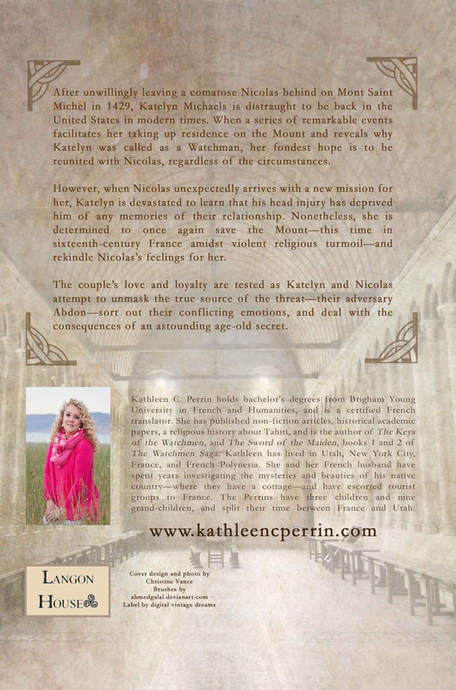
May 2017
Hi friends!
I know you’ve all been wondering where I’ve been hiding. Several of you have even emailed me to see if I perhaps died or disappeared from off the face of the earth!
Yes, it’s true I did spend six weeks in France, but during that time, my manuscript was at the editor’s. After the editor completed her part of the review, my incredible peer reviewers have been hard at work going over their advanced reader copies. They came up with great input and suggestions, which I have been implementing. I promise I have been at my desk for the past two months with my head buried in the book, rewriting, reviewing and editing. In spite of my optimism in thinking I could get The Secret of the Abbey published by April, I didn’t want to release it until it was the best it could be.
So now, I am finally on the last leg of the process and the book will be available by the first week of June. This is just a heads up for you to let you know it is coming soon. I’ll send out another newsletter with the exact date it will be available on Amazon.
For any of you living in the Salt Lake City area, I will be having a signing for paper copies on Saturday, June 10, 2017 and Friday, June 16, 2017. If you are interested in attending, contact me at perrinkc@ymail.com and I will give you the exact time and place.
Once again, thank you for your interest and support. I hope you will feel satisfied with how The Watchmen Saga ends and that you will have all of your questions answered. As always, I would truly appreciate your reviews on Goodreads and Amazon after you’ve read the book. And please, spread the word about The Watchmen Saga. For those of you who can download attachments, I have attached a copy of the front and back cover with this email so you can see the final cover and read the book summary.
I’ll be in touch soon,
Kathleen
Hi friends!
I know you’ve all been wondering where I’ve been hiding. Several of you have even emailed me to see if I perhaps died or disappeared from off the face of the earth!
Yes, it’s true I did spend six weeks in France, but during that time, my manuscript was at the editor’s. After the editor completed her part of the review, my incredible peer reviewers have been hard at work going over their advanced reader copies. They came up with great input and suggestions, which I have been implementing. I promise I have been at my desk for the past two months with my head buried in the book, rewriting, reviewing and editing. In spite of my optimism in thinking I could get The Secret of the Abbey published by April, I didn’t want to release it until it was the best it could be.
So now, I am finally on the last leg of the process and the book will be available by the first week of June. This is just a heads up for you to let you know it is coming soon. I’ll send out another newsletter with the exact date it will be available on Amazon.
For any of you living in the Salt Lake City area, I will be having a signing for paper copies on Saturday, June 10, 2017 and Friday, June 16, 2017. If you are interested in attending, contact me at perrinkc@ymail.com and I will give you the exact time and place.
Once again, thank you for your interest and support. I hope you will feel satisfied with how The Watchmen Saga ends and that you will have all of your questions answered. As always, I would truly appreciate your reviews on Goodreads and Amazon after you’ve read the book. And please, spread the word about The Watchmen Saga. For those of you who can download attachments, I have attached a copy of the front and back cover with this email so you can see the final cover and read the book summary.
I’ll be in touch soon,
Kathleen
February 2017
Good news. I have just finished writing The Secret of the Abbey, Book III and the final book in The Watchmen Saga. Hooray! However, don’t get too excited yet. The book is now going through the editing and review process, which will take a couple of months. I hope to have it out in May or early June. I’ll let you know the exact date it will be available as the time gets closer.
I would like to share with you some very personal experiences I have had while working on this project. This third book has been a long and interesting process because Katelyn’s story took me on some unexpected turns I didn’t expect. When I wrote Jehanne’s story in The Sword of the Maiden, my husband and I traveled to France in the winter and followed in her footsteps. My inspiration to tell her story came by actually being there in those places she had been. One night as we slept at a hotel not far from Domrémy, Joan of Arc’s birthplace, I awoke in the middle of the night flooded with ideas of how to tell her story. I spent two hours in the middle of that night (while my husband slept) trying to write those thoughts down as quickly as I could.
Well, this final book has been just as amazing in a different way. After three research trips to France in 2016, “Katelyn” let me know that I was headed in the wrong direction, a direction I had well-planned out when I first started writing the series of three books. However, after spending months and hours researching the period of the French Revolution, “she” let me know that I had it all wrong. While the Revolution is an incredibly important and turbulent period in French history, it wasn’t where the final chapter of Katelyn’s and Nicolas’s story takes place. So I had to scrap everything I had outlined, and start from scratch, setting the final book in a completely different era I had never considered earlier, which is why I wasn’t able to get the book out in December. It was as if in spite of my preconceived ideas, Katelyn was telling me her story, and she certainly took me in a direction I didn’t expect. Once I listened to that prompting, everything fell into place, but I had a lot of catching up to do.
In my October Newsletter, I revealed the image that will be on the cover of The Secret of the Abbey. It is a photo of Le Chateau de la Bretesche, (above photo), and it is located in the town of Missillac France, in southeastern Brittany. The chateau is currently privately owned and there is a 4-star hotel on its grounds. It is a beautiful place, which plays an important role in Book III.
Below are photos of another site featured in The Secret of the Abbey. This is the river harbor (Vilaine River of Brittany) of the town of La Roche Bernard, not far from Missillac.
I would like to share with you some very personal experiences I have had while working on this project. This third book has been a long and interesting process because Katelyn’s story took me on some unexpected turns I didn’t expect. When I wrote Jehanne’s story in The Sword of the Maiden, my husband and I traveled to France in the winter and followed in her footsteps. My inspiration to tell her story came by actually being there in those places she had been. One night as we slept at a hotel not far from Domrémy, Joan of Arc’s birthplace, I awoke in the middle of the night flooded with ideas of how to tell her story. I spent two hours in the middle of that night (while my husband slept) trying to write those thoughts down as quickly as I could.
Well, this final book has been just as amazing in a different way. After three research trips to France in 2016, “Katelyn” let me know that I was headed in the wrong direction, a direction I had well-planned out when I first started writing the series of three books. However, after spending months and hours researching the period of the French Revolution, “she” let me know that I had it all wrong. While the Revolution is an incredibly important and turbulent period in French history, it wasn’t where the final chapter of Katelyn’s and Nicolas’s story takes place. So I had to scrap everything I had outlined, and start from scratch, setting the final book in a completely different era I had never considered earlier, which is why I wasn’t able to get the book out in December. It was as if in spite of my preconceived ideas, Katelyn was telling me her story, and she certainly took me in a direction I didn’t expect. Once I listened to that prompting, everything fell into place, but I had a lot of catching up to do.
In my October Newsletter, I revealed the image that will be on the cover of The Secret of the Abbey. It is a photo of Le Chateau de la Bretesche, (above photo), and it is located in the town of Missillac France, in southeastern Brittany. The chateau is currently privately owned and there is a 4-star hotel on its grounds. It is a beautiful place, which plays an important role in Book III.
Below are photos of another site featured in The Secret of the Abbey. This is the river harbor (Vilaine River of Brittany) of the town of La Roche Bernard, not far from Missillac.
Finally, here are two photos of another site that plays a critical role in Book III: the Chateau Montgommery (sometimes spelled Montgomery), in Ducey, Normandy, not far from Mont Saint Michel.
If you do some digging about these locations, you may be able to find the important historical events that tie these three places together. But, let me warn you, it’s not an easy task because Wikipedia in English alone might not have the answers you are seeking. Just know that I followed Katelyn’s guidance, and her story is now concluded to her satisfaction. I also promise you that you’ll have answers to all the questions I listed in my October Newsletter (below).
I’m off to France for some final photo taking so that once the book comes out, I will be able to post photos on my website of the many sites introduced in The Secret of the Abbey. And, yes, I admit, I am also looking forward to some rest and relaxation! Thanks once again for your interest and support. I appreciate all of you.
I’m off to France for some final photo taking so that once the book comes out, I will be able to post photos on my website of the many sites introduced in The Secret of the Abbey. And, yes, I admit, I am also looking forward to some rest and relaxation! Thanks once again for your interest and support. I appreciate all of you.
December 2016
Happy Holidays Everyone,
I hope you all had a wonderful Thanksgiving. We certainly did. We were lucky to have lots of family and friends at our home to celebrate with us.
I also had a wonderful visit to France in October with my husband, my sister, and my brother-in-law, with whom we wanted to share some of our favorite places in Brittany and Normandy. We were fortunate enough to enjoy fabulous weather, which made photo-taking a real pleasure. Today, I will share with you a few sites that appear in Book 3 of The Watchmen Saga, The Secret of the Abbey. For this final adventure in the saga, we will be staying put at Mont Saint Michel and in Normandy and Brittany. In this letter, I will introduce you to three small towns in Lower Normandy that appear in the novel.
1. Genêts and Tombelaine Island: The small town of Genêts sits along the Normandy shore of the Bay of Mont Saint Michel west of Avranches and offers a different perspective of the tidal islands (see photo above). As we walked along the township’s sandy beach, we came upon a fantastic bit of local color, two delightful fishermen who allowed me to photograph them. They told us they had been up since four in the morning, traipsing out into the bay at low tide to gather shrimp. From this vantage point you can see Mont Saint Michel in the background on the left, and in the middle foreground is the island of Tombelaine, the island where errant monks were exiled during the Middle Ages. In The Secret of the Abbey, you will learn about an important historical role Tombelaine played in another turbulent period of French history. The town of Genêts is also featured in the story.
I hope you all had a wonderful Thanksgiving. We certainly did. We were lucky to have lots of family and friends at our home to celebrate with us.
I also had a wonderful visit to France in October with my husband, my sister, and my brother-in-law, with whom we wanted to share some of our favorite places in Brittany and Normandy. We were fortunate enough to enjoy fabulous weather, which made photo-taking a real pleasure. Today, I will share with you a few sites that appear in Book 3 of The Watchmen Saga, The Secret of the Abbey. For this final adventure in the saga, we will be staying put at Mont Saint Michel and in Normandy and Brittany. In this letter, I will introduce you to three small towns in Lower Normandy that appear in the novel.
1. Genêts and Tombelaine Island: The small town of Genêts sits along the Normandy shore of the Bay of Mont Saint Michel west of Avranches and offers a different perspective of the tidal islands (see photo above). As we walked along the township’s sandy beach, we came upon a fantastic bit of local color, two delightful fishermen who allowed me to photograph them. They told us they had been up since four in the morning, traipsing out into the bay at low tide to gather shrimp. From this vantage point you can see Mont Saint Michel in the background on the left, and in the middle foreground is the island of Tombelaine, the island where errant monks were exiled during the Middle Ages. In The Secret of the Abbey, you will learn about an important historical role Tombelaine played in another turbulent period of French history. The town of Genêts is also featured in the story.
2. Ducey, Normandy: One of the sites that plays a significant role in The Secret of the Abbey is the Montgommery Château in the small town of Ducey, just ten miles east of the Mount. And no, it is not the chateau featured on the book cover. I will reveal that specific site to you in my next newsletter. If you do a bit of digging about the chateau you might just figure out the period in which Book 3 takes place. Although it is more of a manor than a chateau, the grounds are lovely, even in late October. I was particularly taken with the “geranium tree.” You have to actually get close enough to touch it to see that it isn’t a tree at all, but a cement “wannabe tree” with a platform filled with potted geraniums. The hill of blooms in front of the chateau was also artfully arranged to appear as a bouquet of flowers spilling out upon the grass. Only in France!

3. Saint James: Although technically Saint James is located in Normandy, it claims to be Breton. And yes, it really is named Saint James, though it is pronounced in the French manner as “San zham!” I know, sounds pretty funny. This little town, just ten miles straight south of Ducey and only about 12 miles from Mont Saint Michel, is home to France’s signature Breton knitwear, named after the town. Founded by William the Conqueror in the 11th century, the small town became renowned for its extensive weaving and draping traditions as well as for its high-quality yarn. In the 1850s, the Legallais family’s small spinning factory, Les Filatures de Saint-James, began producing the side-buttoning blue and white striped Breton nautical sweater, which was designed to protect fishermen from the elements during long days and nights at sea. Each sweater requires 18 specific steps to make, taking over 15 days of work by highly trained artisanal knitters.
Since then, the Saint James blue and white knitwear has become an iconic symbol of all of Brittany. Beginning in 1858, the company has also been the maker of part of the official French naval uniform, the Breton striped shirt in combed cotton jersey. According to Breton lore, the 21 stripes each correspond to one of Napoleon’s naval victories over the British fleet. You can visit the factory and factory store in the small town, which has a population of only about 3,000. Just a warning, however, Saint James sweaters are not cheap! And as you can see, the silouhette of Mont Saint Michel is a part of their logo. Né de la mer means: "born from the sea."
Since then, the Saint James blue and white knitwear has become an iconic symbol of all of Brittany. Beginning in 1858, the company has also been the maker of part of the official French naval uniform, the Breton striped shirt in combed cotton jersey. According to Breton lore, the 21 stripes each correspond to one of Napoleon’s naval victories over the British fleet. You can visit the factory and factory store in the small town, which has a population of only about 3,000. Just a warning, however, Saint James sweaters are not cheap! And as you can see, the silouhette of Mont Saint Michel is a part of their logo. Né de la mer means: "born from the sea."
But wait, there’s more! Saint James is also the location of a little-known American WWII Cemetery called The Brittany American Cemetery, of which very few French or Americans are even aware. On a beautiful 28-acre site just outside the town, which has been deeded over to the American government, some 4,409 American soldiers are interred, including 21 sets of brothers. Three days after the U.S. 8th Infantry Division liberated the site on August 2, 1944, it became a temporary military cemetery and it evolved into a permanent military cemetery after the war was over. The site also includes a memorial with the names of some 500 American soldiers listed as missing in action.
If you ever have the opportunity of visiting Mont Saint Michel, don’t miss this stop. The cemetery is open daily to the public from 9 a.m. to 5 p.m. except for Christmas Day and January 1. A staff member is always on duty in the small Visitor’s Center to answer questions and to escort relatives to grave and memorial sites. Like the much better-known Normandy American Cemetery overlooking Omaha Beach, this cemetery is cared for exquisitely. One immediately feels the hallowed nature of the place as well as a deep appreciation for the American Battle Monuments Commission, which cares for some 25 American cemeteries and 26 memorials, monuments and markers in 16 countries around the world. The first chairman of this commission, General John J. Pershing, promised that “time will not dim the glory of their deeds,” and indeed, it hasn’t. Time virtually stands still as one gazes upon the perfectly aligned crosses, with the occasional Star of David intermixed, and contemplates the true price of freedom. It is hallowed ground.

While we were there, the Army Air Corp’s signature theme song, “Off We Go into the Wild Blue Yonder,” (click to hear Bing Crosby sing the song) rang out from the chapel bells. It was the only song we heard during our visit, and both my sister and I were deeply touched, as we both remember our father singing this song to us as young children. As I have mentioned before, my father was a member of the Army Air Corps and participated in the D-Day air assault and the Battle of Normandy. It was as if he had arranged for us to hear this meaningful music as we walked among the graves of those American soldiers who did not make it back home as our father fortunately did. We were also privileged to meet the American Superintendent of the Cemetery who graciously welcomed us and shared some of his insights with us. He lives on site with his wife and supervises a small workforce of French grounds men and office staff, who are equally as respectful and helpful to visitors.
So, now that I have you thoroughly confused about the historical background of The Secret of the Abbey, I hope you will enjoy learning how and where the places above fit into the novel’s setting. In the next newsletter, I’ll share some sites from Brittany.
Let me just finish by wishing all of you a very Merry Christmas and a Happy and Healthy New Year.
Kathleen
Let me just finish by wishing all of you a very Merry Christmas and a Happy and Healthy New Year.
Kathleen
October 2016
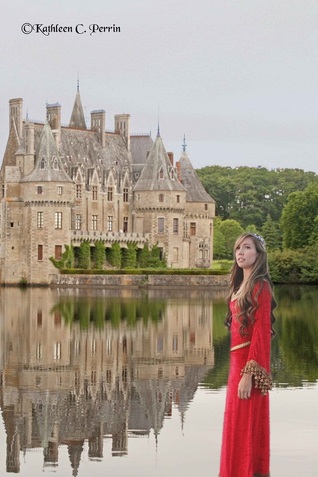
Hi All!
I’ve been a little slow to get this letter out because I wanted to give you a publication date for Book 3 in THE WATCHMEN SAGA. Unfortunately, I still can’t give you a firm release date, and in spite of my good intentions to have it out this December, it won’t be released until the first quarter of 2017. However, I do want to give you an update on the book before I leave for my last trip to France of 2016. More about that when I return.
So now, for the first time anywhere, I am revealing exclusively to you, my newsletter readers, a preview of the cover and the name of the book. Here is a sneak peak at the preliminary cover:
And as for the name of the book, drum rolls please………………............
THE SECRET OF THE ABBEY
Yes, folks, in THE SECRET OF THE ABBEY, the last installment of the saga, you will finally have all your questions answered. Maybe you’ve already discovered the secret, or think you have. Maybe you’ve guessed at some of the answers, but still have a lot of questions. Maybe you don’t have any questions at all, and you’ve just been enjoying the setting, history or storyline, or maybe you don’t have a clue what I’m talking about! But some of your questions should be:
1. Why was Katelyn chosen as a Watchman? Is it her 21st century techie skills alone, or is there a more significant reason?
2. What is the meaning of the Hebrew letters on the time travel keys?
3. Why is Mont Saint Michel so sacred?
4. What is the big secret the Watchmen have been called upon to protect with their lives?
5. What is so special about Mont Saint Michel Abbey, and specifically about the chapel Notre-Dame-Sous-Terre?
6. Will Katelyn finally learn the secret for herself?
7. How does the Prologue of THE KEYS OF THE WATCHMEN, relate to that secret?
You probably have other questions I haven’t mentioned, but hopefully, they will all be answered in THE SECRET OF THE ABBEY. And of course, there will be answers to the questions every reader is asking: Will Katelyn and Nicolas find a way to be together permanently? If so, in what time period? How will they make it work? Will they continue to be Watchmen?
And now, here are some new questions to ponder. Let’s start with the cover:
What does the cover photo have to do with the story? Where was the photo taken?
What time period will Katelyn be sent to next?
Will Nicolas recover his memory and still have feelings for Katelyn?
Will someone else win the affections of Nicolas and/or Katelyn?
What will be the new threat to Mont Saint Michel that Katelyn must address?
The answers to all the above questions will be revealed in THE SECRET OF THE ABBEY, so stay tuned for more information about the release date. And once again, thanks for your interest and support!
Kathleen
I’ve been a little slow to get this letter out because I wanted to give you a publication date for Book 3 in THE WATCHMEN SAGA. Unfortunately, I still can’t give you a firm release date, and in spite of my good intentions to have it out this December, it won’t be released until the first quarter of 2017. However, I do want to give you an update on the book before I leave for my last trip to France of 2016. More about that when I return.
So now, for the first time anywhere, I am revealing exclusively to you, my newsletter readers, a preview of the cover and the name of the book. Here is a sneak peak at the preliminary cover:
And as for the name of the book, drum rolls please………………............
THE SECRET OF THE ABBEY
Yes, folks, in THE SECRET OF THE ABBEY, the last installment of the saga, you will finally have all your questions answered. Maybe you’ve already discovered the secret, or think you have. Maybe you’ve guessed at some of the answers, but still have a lot of questions. Maybe you don’t have any questions at all, and you’ve just been enjoying the setting, history or storyline, or maybe you don’t have a clue what I’m talking about! But some of your questions should be:
1. Why was Katelyn chosen as a Watchman? Is it her 21st century techie skills alone, or is there a more significant reason?
2. What is the meaning of the Hebrew letters on the time travel keys?
3. Why is Mont Saint Michel so sacred?
4. What is the big secret the Watchmen have been called upon to protect with their lives?
5. What is so special about Mont Saint Michel Abbey, and specifically about the chapel Notre-Dame-Sous-Terre?
6. Will Katelyn finally learn the secret for herself?
7. How does the Prologue of THE KEYS OF THE WATCHMEN, relate to that secret?
You probably have other questions I haven’t mentioned, but hopefully, they will all be answered in THE SECRET OF THE ABBEY. And of course, there will be answers to the questions every reader is asking: Will Katelyn and Nicolas find a way to be together permanently? If so, in what time period? How will they make it work? Will they continue to be Watchmen?
And now, here are some new questions to ponder. Let’s start with the cover:
What does the cover photo have to do with the story? Where was the photo taken?
What time period will Katelyn be sent to next?
Will Nicolas recover his memory and still have feelings for Katelyn?
Will someone else win the affections of Nicolas and/or Katelyn?
What will be the new threat to Mont Saint Michel that Katelyn must address?
The answers to all the above questions will be revealed in THE SECRET OF THE ABBEY, so stay tuned for more information about the release date. And once again, thanks for your interest and support!
Kathleen
July 2016

As you know, I love medieval French history, but I also happen to be passionately interested in World War II, especially in the European theatre. I think perhaps it is because my father served in what was then called the Army Air Corps (which is now the U.S. Air Force) during the war. He was based in England and flew bombing missions over France and Germany. Add to that the fact that my husband's parents were both heavily impacted by the war.
My father-in-law had served in the French military before Germany occupied France, was held briefly as a prisoner of war, and then was conscripted by the Nazis to work to keep the French railroads viable. My mother-in-law lived in a little village in Brittany in occupied France and was forced to sew and repair uniforms for the Germans. As we commemorated American Independence Day last week, I was reminded of the many sacrifices made to keep America (and France) free. Freedom comes at a heavy cost. We must never forget those sacrifices, and we cannot fail to teach our children about them. I have visited the D-Day landing beaches in Normandy on many occasions, in fact too many times to count, but bar none, the most memorable visit was the year my husband and I took both my parents and his parents along with our three young children to visit those sites together. I wrote an article about that special visit and posted it on my blog, so please check it out: Normandy Revisited
I hope you all had a wonderful 4th of July.
My father-in-law had served in the French military before Germany occupied France, was held briefly as a prisoner of war, and then was conscripted by the Nazis to work to keep the French railroads viable. My mother-in-law lived in a little village in Brittany in occupied France and was forced to sew and repair uniforms for the Germans. As we commemorated American Independence Day last week, I was reminded of the many sacrifices made to keep America (and France) free. Freedom comes at a heavy cost. We must never forget those sacrifices, and we cannot fail to teach our children about them. I have visited the D-Day landing beaches in Normandy on many occasions, in fact too many times to count, but bar none, the most memorable visit was the year my husband and I took both my parents and his parents along with our three young children to visit those sites together. I wrote an article about that special visit and posted it on my blog, so please check it out: Normandy Revisited
I hope you all had a wonderful 4th of July.
June 2016
